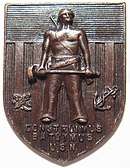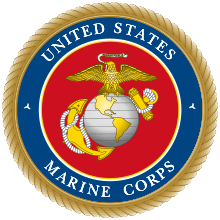Seabee
United States Naval Construction Battalions, better known as the Navy Seabees, form the U.S. Naval Construction Force (NCF). The Seabee nickname is a heterograph of the first letters "C B" from the words Construction Battalion.[1] Depending upon how the word is used "Seabee" can refer to one of three things: all enlisted personnel in the USN's occupational field 7 (OF-7), all officers and enlisted assigned to the Naval Construction Force (NCF), or Construction Battalions. Seabees serve outside the NCF as well. During WWII they served in both the Naval Combat Demolition Units and the Underwater Demolition Teams (UDTs). In addition, they served as elements of Cubs, Lions, Acorns and the United States Marine Corps.[2] They also provided the manpower for the top secret CWS Flame Tank Group. Today they have many special task assignments starting with Camp David and the Naval Support Unit at the Department of State. Seabees serve under both Commanders of the Naval Surface Forces Atlantic/Pacific fleets as well as on many base Public Works and USN diving commands.
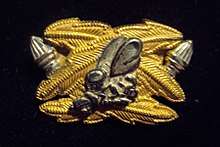

| Naval Construction Battalions | |
|---|---|
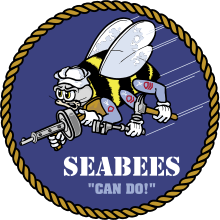 The Seabee logo | |
| Branch | U.S. Navy |
| Type | Expeditionary Forces |
| Role | Militarized construction |
| Size |
|
| Nickname(s) | Seabees |
| Motto(s) |
|
| Colors | |
| Mascot(s) | Bumblebee |
| Anniversaries | 28 December 1941 requested 5 March 1942 authorized |
| Engagements | Guadalcanal, Bougainville, Cape Gloucester, Los Negros, Guam, Peleliu, Tarawa, Kwajalein, Saipan, Tinian, Iwo Jima, Philippines, Okinawa, North Africa, Sicily, Anzio, Normandy, Inchon landing, Khe Sanh, Dong Xaoi, Chu Lai, Con Thien, Desert Storm, Iraq War, and Enduring Freedom |
| Website | https://www.public.navy.mil/seabee/Pages/default.aspx |
| Commanders | |
| Notable commanders | Admiral Ben Moreell |
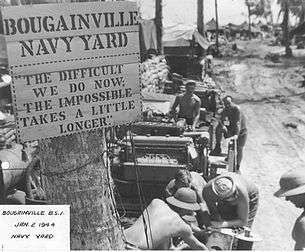

Naval Construction Battalions were conceived as a replacement for civilian construction companies on contract to the Navy after the U.S. was attacked at Pearl Harbor. At that time civilian contractors had roughly 70,000 men working on U.S. bases overseas. International law made it illegal for civilian workers to resist an attack. To do so would classify them as guerrillas and could lead to summary execution.[3] That is exactly what happened when the Japanese invaded Wake Island[4] and would serve as the backstory to the WWII movie "The Fighting Seabees".
Adm. Moreell's concept model CB was a USMC trained battalion of construction tradesmen: A military equivalent of those civilian companies, capable of any type of construction, anywhere needed, under any conditions or circumstances.[5] It was realized that CBs were flexible, adaptable and could be utilized in every theater of operations. The use of USMC organization allowed for smooth co-ordination, integration or interface between NCF and Marine Corps elements. Additionally, CBs could be deployed individually or in multiples as the project scope and scale dictated. What distinguishes Seabees from Combat Engineers are the skill sets. Combat Engineering is but a sub-set in the Seabee toolbox. They have a storied legacy of creative field ingenuity,[6] stretching from Normandy and Okinawa to Iraq and Afghanistan. Adm. Ernest King wrote to the Seabees on their second anniversary, "Your ingenuity and fortitude have become a legend in the naval service."[7] Seabees believe that anything they are tasked with, they "Can Do". They were unique at conception and remain unchanged from Adm. Moreell's model today. In the October 1944 issue of Flying, the Seabees are described as "a phenomenon of World War II".[8] Since their creation, all Seabee advanced military training has been under USMC instruction. Even so, they always bring their toolbox. One of those tools is the ingenuity Admiral King referenced. They gained fame for their application of it during WWII. The UDTs and flamethrowing tanks are declassified top secret examples. Postwar they followed with more of the same for the CIA and State Department. Together with their USMC training and ability to appropriate anything, they provide the Navy an unconventional asset found nowhere else in the U.S military.
Naval construction history
CB Conceptual Formation
Pre-WWII, the concept pioneered in 1917 by the Twelfth Regiment had not been forgotten by the Navy's Civil Engineers. Planning at Bureau of Yards and Docks (BuDocks) began providing for "Navy Construction Battalions" (CB) in contingency war plans.[9] In 1934, Capt. Carl Carlson's version of the CB was approved by Chief of Naval Operations[10]
In 1935, RADM. Norman Smith, head of BuDocks, selected Captain Walter Allen, War Plans Officer, to represent BuDocks on the War Plans Board. Capt. Allen presented the bureau's Construction Battalion concept and the Board included it in the Rainbow war plans.[10] The Seabees named their first training center for Capt. Allen.[11]
The proposal was criticized because the Seabees would have a dual command; military control administrated by fleet line Officers while construction operations would be administrated by Civil Engineer Corps officers.[10] Another issue was no provision for the military organization or military training necessary to provide unit structure, discipline, and esprit de corps. In December 1937, RADM. Ben Moreell became BuDocks Chief and the lead proponent of the CB proposal.[10]
In 1941 civilian contractors were working on numerous projects for the Navy and BuDocks decided to improve project oversight by creating "Headquarters Construction Companies".[10] These companies would have 2 officers and 99 enlisted, but would do no actual construction.[10] On October 31 1941, RADM. Chester Nimitz, Chief of the Bureau of Navigation, authorized the formation of the 1st Headquarters Construction Company.[10] Recruitment began in November and boot training began December 7 at Naval Station Newport, Rhode Island.[10] By December 16, four additional companies had been authorized, but Pearl Harbor had changed all the plans.[10]
World War II
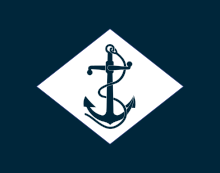
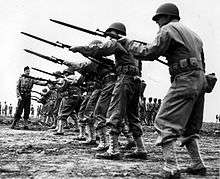
On December 28, 1941, RADM Moreell requested authority to commission three Naval Construction Battalions. His request was approved on January 5, 1942 by Admiral Nimitz.[13] The 1st HQ Construction Company was used to commission the 1st Naval Construction Detachment, which was assigned to Operation Bobcat.[14] They were sent to Bora Bora and are known in Seabee history as "Bobcats".[14]
Concurrently, the other four requested HQ Construction Companies had been approved. BuDocks took Companies 2 & 3 to form the 1st Naval Construction Battalion at Charleston, South Carolina. HQ Companies 4 & 5 were used for the 2nd CB.[13] All four deployed as independent units. CBs 3, 4, & 5 were all deployed similarly.[15] CB 6 was the first battalion to deploy full complement to the same deployment site.[15]
Before all this could happen, BuDocks had to address the dual command issue. Naval regs stated unit command was strictly limited to line officers. BuDocks deemed it essential that CBs be commanded by CEC officers trained in construction. The Bureau of Naval Personnel (BuPers) strongly opposed this. Adm. Moreell took the issue directly to the Secretary of the Navy, Frank Knox. On March 19, 1942, Knox gave the Civil Engineer Corps complete command of all Naval Construction units. Almost 11,400 would become CEC during WWII with 7,960 doing CB service. Two weeks prior, on March 5th all construction battalion personnel were officially named "Seabees".
The first volunteers were construction tradesmen who were given advanced rank for their trade skills. This would result in them being the highest-paid group in uniform.[16] To recruit these men, age and physical standards were waived up to age 50. Until November 1942 the average recruit age was 37, even so all received the same physical training.[4] In December, FDR ordered the Selective Service System to provide CB recruits. Enlistees could request CB service with a written statement certifying that they were trade qualified.[1]:136 This lasted until October 1943 when voluntary enlistment in the Seabees ceased until December 1944.[1]:136 By war's end, 258,872 officers and enlisted had served in the Seabees. They never reached the Navy's authorized quota of 321,056.[17]
In 1942 initial CB boot was Camp Allen,VA., which moved to Camp Bradford, which moved to Camp Peary[4] and finally moved to Camp Endicott, Rhode Island. CBs 1-5 were sent directly overseas for urgent projects. CBs that followed were sent to Advance Base Depots (ABDs) for deployment.[18] Camp Rousseau at Port Hueneme became operational first and was the ABD to the Pacific.[19] The Davisville ABD became operational in June with NTC Camp Endicott commissioned that August.[20] Other CB Camps were Camp Parks, Livermore, Ca.,[21] and Camp Lee-Stephenson, Quoddy Village, Eastport, Maine[22] and Camp Holliday, Gulfport, Ms. CBs sent to the Pacific were attached to one of the four Amphibious Corps: I, III, and V were USMC. The VII Amphibious Force was under General Douglas MacArthur, Supereme Commander.
Advance Bases
The Office of Naval Operations created a code identifying Advance Base (AB)[23] construction as a numbered metaphor for the size/type of base. That code was also used to identify the "unit" that would be the administration for that base.[24] These were Lion, Cub, Oak and Acorn with a Lion being a main Fleet Base (numbered 1–6).[25] Cubs were Secondary Fleet Bases 1/4 the size of a Lion (numbered 1–12).[26] Oak and Acorn were the names given air installations, new or captured (airfield or airstrip).[27] Cubs quickly gained status. The speed with which the Seabees could make one operational led the Marines to consider them a tactical component. Camp Bedilion shared a common fence-line with Camp Rousseau at Port Hueneme and was home to the Acorn Assembly and Training Detachment (AATD)[28] As the war progressed, BuDocks realized that logistics required that Advance Base Construction Depots (ABCDs) be built and CBs built seven.[29] When the code was first created, BuDocks foresaw two CBs constructing a Lion. By 1944 an entire Regiment was being used. The invasion of Okinawa took four Construction Brigades of 55,000 men. The Seabees built the infrastructure needed to take the war to Japan. By war's end CBs had, served on six continents, constructed over 300 bases on as many islands.[30] They built everything: airfields, airstrips, piers, wharves, breakwaters, PT & seaplane bases, bridges, roads, com-centers, fuel farms, hospitals, barracks and anything else.[31]
Atlantic In the Atlantic Seabees biggest job was the preparations for the Normandy landing. Months later CBMUs 627, 628, and 629 were tasked to facilitate the crossing of the Rhine. For CBMU 629 it was front-line work.[32]


Marine Corps, Seabees outside the NCF
USMC historian Gordon L. Rottman wrote "that one of the biggest contributions the Navy made to the Marine Corps during WWII was the creation of the Seabees".[36] As part of that contribution the Corps would be influential upon the CB organization and its history. After the experience of Guadalcanal the Department of War decided that the Marines and Seabees would make all subsequent landings together.[37] The Order of battle would show the Seabees as being attached to the Marine Corps. That arrangement lead to numerous good-natured claims by the Seabees that they had landed first and signs left on the beach saying "What took you so long?"[37] The Seabees in the UDTs made an effort of this.[37]
When the first three battalions were formed the Seabees did not have a fully functional base of their own. Upon leaving navy boot camp the first recruits were sent to National Youth Administration camps in Illinois, New Jersey, New York, and Virginia to receive military training from the Marine Corps.[1]:138 The Marine Corps listed CBs on their Table of organization: "D-Series Division" for 1942,[38] "E-Series Division" for 1943,[39][40] and "Amphibious Corps" for 1944/45.[41]
When the Seabees were created the Marine Corps wanted one for each of the three Marine Divisions but were told no because of war priorities. That did not keep early Seabee units from having close contact with the Marine Corps The 1st Naval Construction Detachment (Bobcats)[14] together with and A Co CB 3 was transferred to the Marines and redesignated 3rd Battalion 22nd Marines. The Bobcats had deployed without receiving advanced military training. The 22nd Marines took care of that.[43] The 4th Construction Detachment was attached to the 5th Marine Defense Battalion for two years.[15]
By autumn, actual CBs, the 18th , 19th and 25th[44] had been transferred to the Corps as combat engineers.[45] Each was attached to a composite engineer regiment[46] and redesignated as 3rd Bn of that Regiment: [45] 17th Marine Regiment, 18th Marine Regiment, 19th Marine Regiment, and 20th Marine Regiment. Along with that came the standard USMC issue.[47] The 18th and 19th CBs both claim to have been the first CB authorized to wear the USMC uniform.[35] Both received their military training and USMC issue at MTC New River, NC. There is no record of how many CBs received USMC issue. It is known that the 31st, 43rd,[48] 76th,[49] 121st and 133rd NCBs received partial or complete issues.[50]
There were numerous USMC/Seabee pairings. The first one in combat was the 6th CB with the 1st Marine Division. The 18th CB was sent as their relief from Fleet Marine Force depot Norfolk.[51] Many more would follow. The 6th Special CB was tasked to the 4th Marines Advance Depot in the Russells.[15] In November, the 14th CB was tasked to the 2nd Raider Bn on Guadalcanal. Earlier in June, the 24th CB was tasked to the 9th Marine Defense Bn on Rendova.[52] The 33rd and 73rd Seabees had a detachment tasked to the 1st Pioneers as shore party for the 5th Marines on Peleliu.[53] Also attached was the 17th Special CB colored. At Enogi Inlet on Munda, the 47th had a detachment support the 1st and 4th Marine Raiders. On Bougainville, the 3rd Marine Div. made CO of the 71st CB shore party commander. The 71st was supported by detachments from the 25th, 53rd, and the 75th CBs.[54] At Cape Torokina the 75th had 100 men volunteer to support the assault of the 3rd Marines.[55] Also at Bougainville, the 53rd provided shore parties to the 2nd Raiders on green beach and the 3rd Raiders on Puruata Island.[56] The 121st was formed at the CB Training Center of MTC Camp Lejuene as 3rd Bn 20th Marines.[57] They would be shore party to the 23rd Marines on Roi-Namur, Saipan, and Tinian.
In 1944 the Marine Engineer Regiments were inactivated. Even so, Marine Divisions still had a CB tasked to them. For Iwo Jima, the 133rd and 31st CBs were attached to the 4th and 5th Marine Divisions. The 133rd was tasked to the 23rd Marines as their shore party.[58] The 31st CB was attached to the 5th Shore Party Regiment with their demolitionsmen attached to the 5th Marine Div.[59][60] The 8th Marine Field Depot was the shore party command eschelon for Iwo Jima. They requested 26 heavy equipment operators from the 8th CB.[61] Okinawa saw the 58th, 71st, 130th, and 145th CBs attached to the 6th, 2nd, and 1st Marine Divisions respectively.
From Iwo Jima the 5th Marine Div. returned to Camp Tarawa to have the 116th CB attached.[60] When Japan fell the 116th CB was part of the occupation force. V-J day found thousands of Japanese troops still in China and the III Marine Amphibious Corps was sent there to get them home. The 33rd NCR was assigned to III Marine Amphib. Corps for this mission.[62]
Seabee Battalions were also tasked individually to the four Amphibious Corps. The 19th CB started out with the I MAC[51] prior to joining the 17th Marines. The 53rd CB was attached to I MAC as Naval Construction Battalion I M.A.C. When I MAC was redesignated III Amphibious Corps the battalion became an element of the 1st Provisional Marine Brigade.[63] For Guam, III Amphibious Corps had the 2nd Special CB, 25th, and 53rd CBs. The CO 3/19 Marines (25 CB) was shore party commander for the 3rd Marines on beaches Red 1 and Red 2. The 3rd Marines would award 25's shore party 17 bronze stars.[64] V Amphibious Corps (VAC) had the 23rd Special and 62nd CBs on Iwo Jima. On Tinian the 6th Construction Brigade was attached to V Amphibious Corps.[65]
- Two sections of CBMU 515 saw combat with the 22nd Marines on Guam.[66]
When the war ended the Seabees had a unique standing with the U.S. Marine Corps.[67] Seabee historian William Bradford Huie wrote "that the two have a camaraderie unknown else-wheres in the U.S. military".[68] Even though they are "Navy" the Seabees adopted USMC fatigues with a Seabee insignia in place of the EGA. At least nine WWII Seabee units incorporated USMC insignia into theirs. Admiral Moreell wrote that the Marines were the best fighting men in the Pacific. Even-so, a leatherneck had to serve 90 days with the Seabees to qualify to as a Junior Seabee.[69]
see Notes
Naval Combat Demolition Units (NCDU)s, Seabees outside the NCF

In early May 1943, a two-phase "Naval Demolition Project" was ordered by the Chief of Naval Operations "to meet a present and urgent requirement" for the invasion of Sicily. Phase-1 began at Amphibious Training Base (ATB) Solomons, Maryland with the creation of Operational Naval Demolition Unit # 1. Six Officers lead by Lt. Fred Wise CEC and eighteen enlisted reported from Camp Peary dynamiting and demolition school.[71] Seabees called them "Demolitioneers".[72]
Naval Combat Demolition Units (NCDUs) consisted of one junior CEC officer,[73] five enlisted, and were numbered 1–216.[74] After that first group had been trained Lt. Commander Draper Kauffman was selected to command the program. It had been set up in Camp Peary's "Area E"(explosives) at the dynamiting and demolition school. Between May and mid-July, the first six NCDU classes graduated at Camp Peary. From there the program moved to Fort Pierce where the first class began mid-July.[75] Despite the move, Camp Peary remained Kauffman's primary recruit center. "He would go back to the dynamite school, assemble the (Seabees) in the auditorium and say, "I need volunteers for hazardous, prolonged and distant duty."[4] Fort Pierce had two Seabee units assigned, CBD 1011 and CBMU 570. They were tasked with the construction and maintenance of obstacles needed for demolition training.
Thirty four NCDUs were assigned to the Invasion of Normandy. When the first 10 units arrived in England they had no commander. So Lt. Smith(CEC) assumed the role and split them into 3 groups to train with the 146th, 277th and 299th Combat Engineers.[76] As more units arrived they were assigned to these groups plus had 5 army engineers attached to them.[77] Group III(Lt. Smith) did research and development and is credited with developing the Hagensen Pack.[76] NCDUs saw a 53 percent casualty rate at Normandy.[4] Four from Utah beach later took part in Operation Dragoon.
With Europe invaded Admiral Turner requisitioned all available NCDUs from Fort Pierce for integration into the UDTs for the Pacific. That requisition order netted Admiral Turner 20 NCDUs that had received Presidential Unit Citations and another 11 that had gotten Navy Unit Commendations at Normandy.[78] Before Normandy 30 NCDUs[79] had been sent to the Pacific while three had gone to the Mediterranean. NCDUs 1–10 were staged at Turner City, Florida Island in the Solomons during January 1944.[80] NCDU 1 went briefly to the Aleutians in 1943.[81] NCDUs 4 and 5 were the first to see combat with the 4th Marines at Green island and Emirau Island.[81] A few were temporarily attached to UDTs. Later NCDUs 1–10 were combined to form Underwater Demolition Team Able. That team was disbanded. NCDUs 2 and 3, plus 19, 20, 21 and 24[82] were assigned to MacArthur's 7th Amphibious Force and were the only NCDUs remaining at the war's end. The other men from Team Able were assigned to numeric UDTs.
see Notes
Underwater Demolition Teams (UDT)s, Seabees outside the NCF
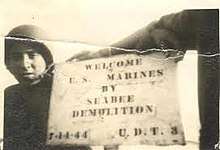
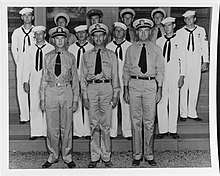
Prior to Operation Galvanic and Tarawa, V Amphibious Corps had identified coral as an issue for future amphibious operations. RADM. Kelly Turner, commander V Amphibious Corps had ordered a review to get a grip on the problem. VAC found that the only people having any applicable experience with the material were men in the Naval Construction Battalions. Lt. Thomas C. Crist, of CB 10, was in Pearl Harbor from Canton Island[84][85] where he had been in charge of clearing coral heads. His being in Pearl Harbor was pivotal in UDT history. While there he learned of the Adm. Turner's interest in coral blasting and met with him. The Admiral tasked Lt. Crist to develop a method for blasting coral under combat conditions and putting together a team to do it.[79] Lt. Crist started by getting men from CB 10. By December 1, 1943 he had close to 30 officers and 150 enlisted at Waipio Amphibious Operating Base on Oahu.[79]
In November the Navy had a hard lesson with coral and tides at Tarawa. It prompted Adm. Turner to request the creation of nine Underwater Demolition Teams to address those issues.[86] Six teams for VAC in the Central Pacific while the other three would go to III Amphibious Corps in the South Pacific. Adm. Turner chose the term "underwater" to distinguish from the Fort Pierce program. UDTs 1 & 2 were formed from the 180 Seabees Lt Crist had staged. Seabees make up the majority of the men in teams 1-9, 13 and 15.[87] How many Seabees were in UDT 10 is not cited in the records nor is anything stated for UDT 12. Seabees were roughly 20% of UDT 11.[88][89] UDT officers were mostly CEC.[90] UDT 10 had 5 officers and 24 enlisted orginally trained as OSS Maritime Unit: Operational Swimmer Group II).[91] but, the OSS was not allowed to operate in the Pacific Theater. Adm. Nimitz needed swimmers and approved their transfer from the OSS to his control. The MU men brought with the swimfins they had trained with and the Seabees made them a part of UDT attire as quickly as the Supply dept. could get them.[91] In the Seabee dominated teams the next largest group of UDT volunteers came from the joint Army-Navy Scouts and Raiders school that was also in Fort Pierce. Additional volunteers came from the Navy's Bomb disposal School, Marine Corps and U.S. Fleet.[79][87]
The first team commanders were Cmdr. E.D. Brewster (CEC) UDT 1 and Lt. Crist (CEC) UDT 2. Both Teams were "provisional" totaling the 180 men Lt Crist had put together.[92] Seven different CBs made up UDT 2.[87] They wore fatigues, life-vests and were expected to stay in boats like the NCDUs. However, at Kwajalein Fort Pierce protocol was changed. Adm.Turner ordered daylight recon, and Ensign Lewis F. Luehrs and Seabee Chief Bill Acheson wore swim trunks under their fatigues. They stripped down, spent 45 minutes in the water in broad daylight. Still wet and in their trunks they were taken directly to Adm. Turner to report. He concluded individual swimmers were the only way to get accurate intel on underwater obstacles, reporting as much to Adm. Nimitz.[93] At Engebi Cmdr. Brewster was wounded and all the men with Ens. Luehrs wore trunks under their fatigues.[79] The success of those UDT 1 Seabees not following Fort Pierce protocol rewrote the UDT mission model and training regimen.[94] Ens. Luehrs and Chief Acheson were each awarded a Silver Star for their exploit[95] while unintentionally creating the UDT "naked warrior" image. Diving masks were not common in 1944 and some had tried using goggles at Kwajalein.[96] They were a rare item in Hawaii so Lt. Crist and CB Chief Howard Roeder had requested supply get them.[96] A fortuitous observation by one of the men spotted a magazine advertisement for diving masks. A priority dispatch was made to the States that appropriated the store's entire stock.[96]
Adm. Turner also requested the formation of a "Naval Combat Demolition Training & Experimental Base" at Kihei. It was approved, with the lessons of UDT 1 incorporated into the training, making it distinctly different from that at Fort Pierce. Lt. Crist was briefly the first training officer until when he was made Commander of UDT 3. When UDT 3 returned from Leyte in November 1944 the team became school instructors and Lt. Crist was again OIC of training.[87] Under Lt. Crist the training course was changed with an emphasis on swimming and recon. Also covered were: night ops, weapons, bivouacking, small unit tactics, along with coral and lava blasting. The team instructed until April 1945 when it was sent to Fort Priece to instruct there. Lt. Crist was promoted to Lt. Cmdr and returned to Hawaii. Team 3 would train teams 12–22.[87] UDT 14 is called the first "all fleet team" even though Seabees from Team Able were attached and the Commander and XO were both CEC (Ltjg. A.B. Onderdonk and Ltjg. C.E. Emery). UDT 15 was the last team formed of NCDUs. Four teams were sent to Iwo Jima. Three were sent to clear the shoreline for five days, D+2 - D+7. After July of 1944 new UDTs were only USN. In 1945 CBMU 570 was tasked to support UDT coldwater training at ATB Oceanside, CA.[97]
On Guam team 8 requested permission to build a base.[98] It was approved by AdComPhibsPac, but disapproved by the Island Command.[98] Team 8 turned to the CBs on the island to appropriate everything they needed.[98] The coral paving got placed the night before Admiral Nimitz made an inspection. The Admiral gave the base and teams 8 & 10 a glowing review.[98]
By V-J day 34 teams had been formed. Teams 1–21 saw actual deployment with the Seabees providing over half of the men in those teams. The Navy did not publicize the existence of the UDTs until post-war and when they did they gave credit to Lt. Cmdr. Kauffman and the Seabees.[99] During WWII the Navy did not have a rating for the UDTs nor did they have an insignia. Those men with the CB rating on their uniforms considered themselves Seabees that were doing underwater demolition. They did not call themselves "UDTs" or "Frogmen", but rather "Demolitioneers"[100] reflecting where LtCdr Kauffman had recruited them from, the CB dynamiting and demolition school.
UDTs had to be of standard recruiting age, Seabees older could not volunteer. In preparation for the invasion of Japan and the cooler waters encircling it, the UDTs created a cold water training center. Mid-year 1945 men had to pass a stricter physical. Team 9 lost 70% of the team to this change.
see Notes
African American Service: the Seabee stevedores
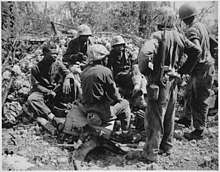
In February 1942 CNO Admiral Harold Rainsford Stark recommended African Americans for ratings in the construction trades. In April the Navy announced it would enlist African Americans in the Seabees. Even so, there were just two CBs that were "colored" units, the 34th and 80th.[102] Both had white Southern officers and black enlisted. Both battalions experienced problems with that arrangement that led to the replacement of the officers. The men of the 34th went on a hunger strike which made national news. The Commander of the 80th had 19 enlisted dishonorably discharged for sedition. The NAACP and Thurgood Marshall got 14 of those reversed. In 1943 the Navy drew up a proposal to raise the number of colored CBs to 5 and require that all non-rated men in the next 24 CBs be colored. The proposal was approved, but not acted on.
The lack of stevedores in combat zones was a huge issue for the Navy. Authorization for the formation of cargo handling CBs or "Special CBs" happened mid-September 1942.[103] By wars end 41 Special CBs had been commissioned of which 15 were "colored". They were the first fully integrated units in the U.S. Navy.[102] V-J Day brought the decommissioning of all of them. The Special CBs were forerunners of today's Navy Cargo Handling Battalions of the Navy Expeditionary Logistics Support Group (United States). The arrival of 15 colored Special CBs in Pearl Harbor made segregation an issue for the Navy.[104] For some time the men slept in tents, but the disparity of treatment was obvious even to the Navy.[104] The 14th Naval District felt they deserved proper shelter with at least separate but equal barracks.[104] Manana Barracks and Waiawa Gulch became the United State's largest colored military installation with over 4,000 Seabee stevedores housed there.[104] It was the site of racial strife to the point that the camp was fenced in and placed under armed guard.[104] The Seabees would be trucked back and forth to the docks in cattle trucks.[104] Two naval supply depots were located at Waiawa Gulch.
The 17th Special(colored) CB at Peleliu 15–18 September 1944 is omitted from the USMC order of battle. On D-day at Peleliu, the 7th Marines were in a situation where they did not have enough men to man the lines and get the wounded to safety. Coming to their aid were the 2 companies of the 16th Marine Field Depot (colored) and the 17th Special CB. The Japanese mounted a counter-attack at 0200 hours on D-day night. By the time it was over, nearly the entire 17th had volunteered to carry ammunition to the front lines on the stretchers they brought the wounded back on. They volunteered to man the line where the wounded had been, man 37mm guns that had lost their crews and volunteered for anything the Marines needed. The 17th remained with the 7th Marines until the right flank had been secured on D plus 3.[105][106][107][108][109] According to the Military History Encyclopedia on the Web, "were it not for the Black Marine shore party---the counterattack on the 7th Marines would not have been repulsed".[110]
- On Peleliu, shore party detachments from the 33rd and 73rd CBs received Presidential Unit Citations as did the primary shore party (1st Marine Pioneers).[111] The Commander of the 17th Special CB (colored) received the same commendatory letter as the Company Commanders of the 7th Marine Ammunition Co. (colored) and the 11th Marine Depot Co. (colored). Before the battle was even over, Maj. Gen. Rupertus, USMC wrote to each:
"The negro race can well be proud of the work performed [by the 11th Marine Depot Co./ 7th Marine Ammunition Co./ 17th Special CB]. The wholehearted co-operation and untiring efforts which demonstrated in every respect that they appreciated the privilege of wearing a Marine uniform and serving with the marines in combat. Please convey to your command these sentiments and inform them that in the eyes of the entire division they have earned a 'well done'."[112][113] The Department of the Navy made an official press release November 28, 1944 of the 17th CB's copy of this letter.[114]
- African American Seabees[115][116]
Seabee North Slope Oil Exploration 1944
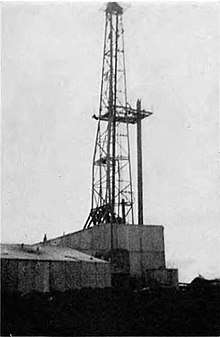
A Construction Battalion Detachment (CBD) was formed from "screening Camp Peary and the NCF for geologists, petroleum engineers, oil drillers, tool pushers, roustabouts and roughnecks" and later designated 1058.[117][118] Many additional enlisted and officers were chosen for their arctic experience with CB 12 and CB 66.[117] The selected men were assembled at Camp Lee Stephenson. Congress had earmarked $1,000,000 for Operation Pet 4 to determine if there was actually oil in NPR 4 (U.S. Navy Petroleum Reserve No. 4) in 1944. NPR-4 had been created and placed in the oil reserve in 1923.[117] Today NPR-4 is the National Petroleum Reserve in Alaska. The detachment's mission was:
- Do a detailed geologic study at Umiat and Cape Simpson
- Drill test and core holes
- Drill a deep well
- Do aerial and overland pipeline surveys.[117]
- Do a complete aerial survey of NPR 4
- Build a base camp with a runway at Point Barrow
- Build field camp runways at Umiat and Bettles
In 1944 the base camp was constructed at Point Barrow. Four D-8s with twenty sleds of supplies were prepped for the 330-mile trek to Umiat once the tundra had frozen.[119] After those supplies were delivered the Cats returned for the heavy well equipment.[119] During the summer of 1945 a 1,816' wildcat was drilled and designated Seabee#1[120] before being shut down by the cold. The well site was near four known seeps at Umiat in the very south-east of NPR 4.[117][119] The rock in the area was from the Upper Cretaceous and a stratum of it was named the "Seabee Formation".[121] On the coast the Seabees drilled test holes at Cape Simpson and Point Barrow.[122] Once the runways were completed additional supplies were flown in. In March 1946 civilians took over the project. Some had been members of CBD 1058 and had been hired immediately upon discharge for the same job they had performed for the Navy."[121] The Navy drew upon the cold weather experience it gained from CBD 1058 and applied it in Operation Highjump and Operation Deep Freeze. – Today Seabee #1 is a USGS monitor well.[123]
Land surveys
Twice the Seabees have been tasked with large scale land surveys. The first was done by CBD 1058 for a proposed NPR 4 pipeline route to Fairbanks. The Trans-Alaskan pipeline follows a portion of their survey from roughly the arctic circle to Fairbanks. The second would be done by a Seabee team from MCB 10. That group was sent to Vietnam in 1956 to survey and map that country's entire road network.[124] This work would be heavily drawn upon during the Vietnam War.
see Notes
WWII Cold War interlude – Siberia, China
On V-J-Day CB 114 was in the Aleutians. In September 1945 the battalion sent a detachment to the USSR to build a Fleet Weather Central.[125][126] It was located 10 miles (16 km) outside Petropavlovsk-Kamchatsky on the Kamchatka Peninsula and code named TAMA.[127] The original agreement gave the Seabees 3 weeks to complete the base. Upon arrival the Russians told the Seabees they had 10 days and were amazed that the Seabees did it.[127] It was one of two that Stalin agreed to. The other was near Khabarousk, Siberia in buildings provided by the Russians.[127]
V-J-Day lead to Operation Beleaguer for the repatriation of the remnants of the Japanese Army left in China. Part of the 33rd CB Regiment was tasked: CBs 83, 96, 122 and 32nd Special.[128] These units landed at Tsingtao and Tangku in November 1945 attached to the 6th Marine Division. CB 42 and A Co. 33rd Special landed at Shanghai attached to Naval Advance Base Unit 13.[129] With the war over, the ongoing discharge men eligible left only enough for one CB and the two CB Specials. The men were consolidated in the 96th[128] with the other units decommissioned. In December the 96th started airfields at Tsingtao and Chinwangtao in support of III Marine Amphibious Corps operations.[128] On 20 May 1946 orders were issued for CB III Marine Amphibious Corps to inactivate 96 CB on 1 August. Prior, the 6th Marine Division was renamed the 3rd Marine Brigade for a short period. The 96th CB was transferred to the 4th Marines, 1st Marine Division and deactivated from them in August.
Cold War: Operation Crossroads
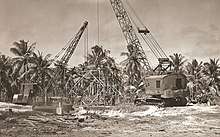
In early 1946 the 53rd NCB was deployed with Operation Crossroads for the nuclear testing at Bikini Atoll.[130] The unit was assigned to Task Group 1.8 and designated TU 1.8.6.[131] 53's project list included observation, instrument and communication towers, radio beacons, seismic huts, photo reference crosses, general base and recreational facilities, as well as dredging the lagoon. From March-May the battalion strength was 1006 including stevedores. The numbers were then drawn down until August 3rd when the battalion was decommissioned. The remaining men were transferred to CBD 1156 that was commissioned on Bikini.[132] The TU 1.8.6 designation continued with them. The CBD remained at the atoll for nine days after the second nuclear test.[133][134]
UDT 3 was designated TU 1.1.3 for the operation. On 27 April 1946, seven officers and 51 enlisted embarked the USS Begor (APD-127) at CBC Port Hueneme, for transit to Bikini.[135] Their assignment was to retrieve water samples from ground zero of the Baker blast. In 1948, the displaced bikinians put in a request that the U.S. Navy blast a channel to the island Kili where they had been relocated. This was given to the Seabee detachment on Kwajelin. They requested UDT 3 assist.
In January 1947, CBs 104 and 105 were reactivated. The 121st CB was decommissioned in December and re-designated CBD 1504.[136] The 30th NCR was home-ported on Guam composed of CBDs 1501-13 and NCB 103. In 1949, the 103rd was made a Mobile Construction Battalion (MCB) while CBs 104 and 105 were made Amphibious Construction Battalions(ACBs). From 1949 until 1968 CBs were designated MCBs. In June 1950 the Naval Construction Force numbered roughly 2,800.
Cold War: Korea
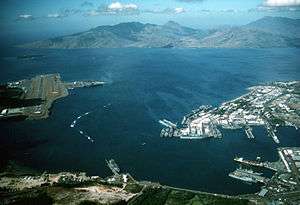

The outbreak of the Korean War led to a call-up of 10,000 from the Seabee Reserve. Seabees landed at Inchon during the assault, installing causeways dealing with enormous tides and enemy fire. Their actions there and elsewheres underscored the necessity of having CBs. During that war the authorized size of a CB was 550 men. When the truce was declared there was no CB demobilization as there had been at the end of WWII.
During the Korea, the U.S. realized the need of an air station in the region. Cubi Point in the Philippines was selected. Civilian contractors were approached for bids. After seeing the Zambales Mountains and the maze of jungle, they claimed it could not be done. The Navy then turned to the Seabees. The first to arrive was CBD 1802 to do the surveying. MCB 3 arrived on 2 October 1951 to get the project going and was joined by MCB 5 in November. Over the next five years, MCBs 2, 7, 9, 11 and CBD 1803 all contributed to the effort. They leveled a mountain to make way for a nearly 2-mile long (3.2 km) runway. NAS Cubi Point turned out to be one of the largest earth-moving projects in the world, equivalent to the construction of the Panama Canal. Seabees there moved 20 million cubic yards (15 million cubic metres) of dry fill plus another 15 million that was hydraulic fill. The $100 million facility was commissioned on 25 July 1956, and comprised an air station and an adjacent pier that was capable of docking the Navy's largest carriers. Adjusted-for-inflation, today's price-tag for what the Seabees built at Cubi Point would be $906,871,323.53.
Seabee Teams The WWII precursor to Seabee teams was the PT Advance base Detachment of the 113th CB. Each man was cross-trained in at least three trades with some qualified as corpsmen and divers.[139] The first Seabees to be actually be referred to as "Seabee Teams" were CBD 1802 and CBD 1803.[140] They were followed by Detachments Able and Baker. Then someone in the U.S. State Department learned of these teams and had an idea for making "good use" of the Seabees in the Cold War. Teams could be sent as "U.S. Good Will Ambassadors" to third world nations as a means to combat the spread of Communism and promote "Good Will", a military version of the Peace Corps. These 13 man teams would construct schools, drill wells or build clinics creating a positive image or rapport for the U.S. They were utilized by the United States Agency for International Development and were in S.E. Asia by the mid 1950s. Then in the early sixties the U.S. Army Special Forces were being sent into rural areas of South Vietnam to develop a self-defense force to counter the Communist threat and making use of the Seabee teams at these same places made sense[141] to the CIA. To start, twelve "Seabee teams, with Secret Clearances, were sent with the Army's Special Forces in the CIA funded Civilian Irregular Defense Group program (CIDG)"[142][143] in the years 1963–1965. By 1965 the U.S. Army had enough engineers in theater to end Seabee involvement with Special Forces. At first teams were called Seabee Technical Assistance Teams (STAT) and were restricted to two in theater at a time. Teams after STAT 1104 were renamed Seabee Teams and by 1969 there were 17 in theater.[143] As a military force Seabee Teams received many awards for heroism.[144] Teams were sent to other nations as well. The Royal Thai government requested STATs in 1963 and ever since the Seabees have continued to deploy teams.
Construction Civic Action Details or CCAD[145] CCADs or "See-Kads" are larger civic action units of 20–25 Seabees[146] with the same purpose as Seabee Teams. The CCAD designation is not found in the record prior to 2013.
Cold War: Antarctica
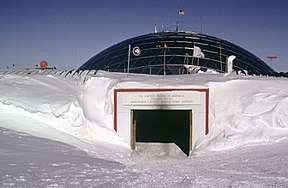

Operation Highjump
In December 1946, 166 Seabees sailed from Port Hueneme on the USS Yancey and USS Merrick assigned to Operation Highjump. They were part of Admiral Richard E. Byrd's Antarctic expedition. The U.S. Navy was in charge with "Classified" orders "to do all it could to establish a basis for a (U.S.) land claim in Antarctica".[147] The Navy sent the Seabees to do the job starting with the construction of Little America (exploration base) IV as well as a runway for aerial mapping flights.[148] This Operation was vastly larger than IGY Operation Deep Freeze that followed.[147]
Operation Deep Freeze
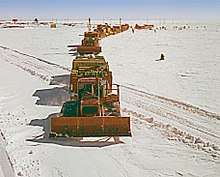
In 1955, Seabees were assigned to Operation Deep Freeze making Antarctica an annual deployment site. Their task was the construction and maintenance of scientific bases for the National Science Foundation. The first "wintering over" crew included 200 Seabees. They cleared an 6,000-foot (1,800 m) ice runway at Mcmurdo for the advance party of Deep Freeze II to fly to South Pole Station. MCB 1 was assigned for Deep Freeze II.
Antarctica added to the Seabee's list of accomplishments:
- Tractor train traverses covering hundreds of miles.
- Bases built: McMurdo Station, South Pole Station, Byrd Station, Palmer Station, Siple Station, Ellsworth Station, Brockton Station, Eights Station, Plateau Station, Hallett Station, and Little America IV and Little America V
- MCB 1s construction of a nuclear power plant[150] which got them a Navy Unit Commendation.
- NMCB 71s construction of a Buckminster Fuller Geodesic dome at So. Pole Station.[151] It became a symbolic icon of the United States Antarctic Research Program (USARP).
see Notes
Cold War: Vietnam
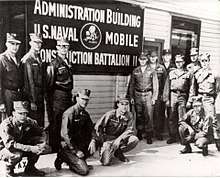

Seabees deployed to Vietnam twice in the 1950s. First in June 1954 as elements of Operation Passage to Freedom and then two years later to map and survey the nation's roads. Seabee teams 501 and 502 arrived on 25 January 1963 and are regarded as the first Seabees of the Vietnam War. They were sent to Dam Pau and Tri Ton to build camps for the Special Forces.[152] In 1964 ACB 1 was the first CB in the theatre. Beginning in 1965 Naval Construction Regiments deployed to the theater. Seabees supported the Marines at Khe Sanh and Chu Lai combat base in addition to building numerous aircraft-support facilities, roads, and bridges. They also worked with and taught construction skills to the Vietnamese. In June 1965, Construction Mechanic 3rd Class Marvin G. Shields of Seabee Team 1104 was at the Battle of Dong Xoai. He was posthumously awarded the Medal of Honor and is the only Seabee to be awarded the medal. Seabee Teams continued to be deployed throughout the Vietnam War and often engaging enemy forces alongside Marines and Army special forces. Teams typically built schools, clinics, or drilled wells. In 1966 Seabees repaired the airfield at Khe Sahn in four days, with 3,900 feet of 60-foot-wide aluminum matting. General Westmoreland "called it one of the most outstanding military engineering feats in Vietnam."[153] MCB 4 had a det at Con Thien whose actions were a near repeat of Dong Xoai.
In 1968 the Marine Corps requested that the Navy make a name change to the CBs to reduce confusion. The Marines were using "MCB" for Marine Corps Base while the Navy was using "MCB" for Mobile Construction Battalions. The Navy added "Naval" to MCB creating the NMCBs that now exist. During that year the 30th Naval Construction Regiment had five battalions in the Da Nang area and two at Chu Lai. The 32nd NCR had three battalions tasked near Phu Bai and one at Dong Ha. In May 1968 two reserve battalions RNMCB 12 and 22 were activated, bring the total number of battalions in Vietnam to 21. Both ACBs were in theater as well as Construction Battalion Maintenance Units (CBMUs) 301 and 302. In 1968 NMCB 10 had an unusual "tasking" supporting the 101st Airborne. During 1969 the Seabees deployed topped out at 29,000, from there their draw-down began.[154] The last battalion withdrew late 1971 with the last Seabee teams out a year later. When it was over they had sent 137 Seabee teams, built 15 CB camps, and deployed 22 battalions.[155] CBMU 302 became the largest CB ever at over 1400 men and was homeported at Cam Rahn Bay. On 23 April 1975 it was announced that U.S. involvement in Vietnam was over. that day saw NMCB 4 start construction of a temporary camp for Operation New Life on Guam. In seven days 2,000 squad tents were put up and 3,500 when done.[156]
During Vietnam the Seabees had a few uniform variations. One was the stenciling of unit numbers across the back of the field jacket M-65.[157] Another was the collar and cover devices for E4 – E6 enlisted. The Navy authorized that the "crow" be replaced by the rating insignia of each trade. Nametags were another, they started out white with a multicolored seabee until 1968 when they followed USMC OD green pattern. The NAVCATs became the only Seabees to ever be authorized to wear a shoulder patch.[158]
NAVCATs Naval Construction Action Teams
CBMU 302 had 23 NAVCATS total with 15 active at its peak.[159] Teams were numbered 1-23. They were Vice Admiral Elmo Zumwalt's expansion of the Seabee Team concept. He submitted it in November 1968 to General Creighton Abrams commander of Military Assistance Command, Vietnam.[160]
Agent Orange Many Seabees were exposed to the defoliant herbicide while in Vietnam. NCBC Gulfport was the largest storage depot in the United States for agent orange. From there it was shipped to Vietnam.[161] In 1968 the NCBC received 68,000 barrels to forward.[162] Long term barrel storage began in 1969. That lasted until 1977. The site covered 30 acres and was still being cleaned up in 2013.[161][163] see Notes0
Cold War: NASA, Tektite I

In 1960 a MCB 10 detachment built a Project Mercury telemetry and ground instrumentation station on Canton island.[164] [165]
On 28 January 1969 a detachment of 50 men[166] from Amphibious Construction Battalion 2 plus 17 Seabee divers began installation of the Tektite habitat in Great Lameshur Bay at Lameshur, U.S. Virgin Islands.[167] The Tektite program was funded by NASA and was the first scientists-in-the-sea program sponsored by the U.S. government.[168] The Seabees also constructed a 12-hut base camp at Viers that is used today as the Virgin Islands Environmental Resource Station.[169] The project was a by product of the space race. It caused the U.S. Navy to realize the need for a permanent Underwater Construction capability that led to the formation the Seabee Underwater Construction Teams".[170]
At present NASA is working on the Moon to Mars program. In 2015 ACB 1 was involved in moving the Orion's Boilerplate Test Article (BTA).[171] ACB 1 was tasked in August of 2019 in a test recovery exercise of the Orion spacecraft.[172] ACB 2 was put through the same task a year later in August 2020.[173]
Cold War: CIA and Naval Intelligence/Communication support
- After the Seabees left Camp Peary the CIA moved into the base and now refer to the it as "the Farm".
- During WWII NAS Tanapag, Saipan was a "giant forward propaganda base for the U.S. Navy and the Office of War Information" (OWI).[174] In 1947 Construction Battalion Detachment 1510 began maintaining NAS Tanapag for the NTTU (Naval Technical Training Unit).[175][176] In 1948 CBD 1510's 256 men were transferred to CBD 1504 about the same time 1504 relieved CB 121 as island Public Works. That year the CIA began using the NTTU as a cover and made access highly restricted to it operation. The CIA station had Capitol Hill constructed to administer its operations at a cost of $28 million. The station covered the entire Northern half of Saipan including both Kagman Field and Marpi Point Field as well as four radio towers.[176] "Brig. Gen. Edward G. Lansdale, Pentagon expert on guerrilla warfare, shared with Gen. Maxwell D. Taylor, President Kennedy's military adviser, on "Resources for Unconventional Warfare in SE. Asia."....that the "CIA maintains a field training station on the island of Saipan ... the installation is under Navy cover and is known as the Naval Technical Training Unit. The primary mission of the Saipan Training Station is to provide physical facilities and competent instructor personnel to fulfill a variety of training requirements including intelligence tradecraft, communications, counter-intelligence and psychological warfare techniques. Training is performed in support of CIA activities conducted throughout the Far East area."[177] The Seabees cease listing the Public Works assignments at NAS Tanapag in 1953 while the CIA remained until 1962. However, MCB 9 deployed to Saipan in 1954 with one of their projects being the up-grading of the Public Works shops.[178] MCB 10 Det Bravo deployed to Saipan from July 1957 until February 1958 with projects unlisted.[179]
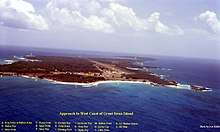
- A year before the Bay of pigs and Cuban Missile Crisis the CIA took a "top secret" urgent/immediate project to the Seabees.[180] The agency wanted two 220' radio towers with a supporting airstrip, dock, and quonsets erected on Swan Island, built asap, with no construction plans for the Seabees.[180] The station would be independent and self powered. Det Tango of MCB 6 was given the project.[180] LSTs 1046 and 1056 were loaded at Quonset Point with all the men and materials required.[180] The Seabees had the CIA's "Radio Swan" on the air in short order.[180]
see Notes
Naval Intelligence: NAVFACs
The Navy built 22 Naval Facilities (NAVFACs) for its Sound Surveillance System (SOSUS) to track Soviet submarines. They were in service 1954–79 with Seabees staffing the Public works at each Facility. In the 1980s technology reduced the number of tracking stations to 11 with advent of the Integrated Underwater Surveillance System (IUSS). NAVFAC tracking facilities were finally undone by further advances in tech, the end of the Cold War and disclosures by John Walker to the Soviets.
The Seabees have also been tasked building Naval Communication facilities. One at Nea Makri Greece was built by MCB 6 in 1962 and later upgraded by NMCB 133. Naval Communications Station Sidi Yahya is another going back to WWII another is NavCommSta Guam. It started out on the island as the Joint Communications Agency (JCA) in 1945.
Cold War: Naval Support Unit: Department of State
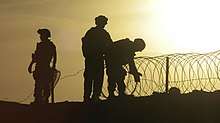
In 1964, at the height of the Cold War, Seabees were assigned to the State Department because listening devices were found in the Embassy of the United States in Moscow.[182] Those initial Seabees were "Naval Mobile Construction Battalion FOUR, Detachment November".[183] The U.S. had just constructed a new embassy in Warsaw. After what had been found in Moscow Seabees were dispatched and found many "bugs" there also. This led to the creation of the Naval Support Unit in 1966 as well as the decision to make it permanent two years later.[184][185] That year William Darrah, a Seabee of the support unit, is credited with saving the U.S. Embassy in Prague, Czechoslovakia from a potentially disastrous fire.[186] In 1986, "as a result of reciprocal expulsions ordered by Washington and Moscow" Seabees were sent to "Moscow and Leningrad to help keep the embassy and the consulate functioning".[187]
The Support Unit has a limited number of special billets for select NCOs, E-5 and above. These Seabees are assigned to the Department of State and attached to Diplomatic Security.[188][182] Those chosen can be assigned to the Regional Security Officer of a specific embassy or be part of a team traveling from one embassy to the next. Duties include the installation of alarm systems, CCTV cameras, electromagnetic locks, safes, vehicle barriers, and securing compounds. They can also assist with the security engineering in sweeping embassies (electronic counter-intelligence). They are tasked with new construction or renovations in security sensitive areas and supervise private contractors in non-sensitive areas.[189] Due to Diplomatic protocol the Support Unit is required to wear civilian clothes most of the time they are on duty and receive a supplemental clothing allowance for this. The information regarding this assignment is very scant, but State Department records in 1985 indicate Department security had 800 employees, plus 1,200 Marines and 115 Seabees.[190] That Seabee number is roughly the same today.[191]
see Notes
Cold War winds down
As the Cold War wound down, new challenges and changes came for the Seabees starting with the increased incidence of terrorism. This was in addition to ongoing Seabee support missions for USN/USMC bases worldwide. Even though the Cold war had wound down Cold War Facilities still required support like the Polaris and Poseidon submarines at Holy Loch, Rota. In 1971, the Seabees began their huge peacetime construction project on Diego Garcia[192] in the Indian Ocean. That project began in 1971 and was completed in 1987 at a cost of $200 million. With the extended construction timeline, it is difficult to inflation-adjust that cost into today's dollars. The complex accommodates the Navy's largest ships and cargo planes. The base served as a staging facility for Operations Desert Shield and Desert Storm. Seabee construction was responsible for the upgrade and expansion of Naval Air Station Sigonella, Sicily, making it a major base for the United States Sixth Fleet.
There were combat related assignments as well. In 1983, a truck bomb demolished the Marine's barracks in Beirut, Lebanon.[192] From the Beirut International Airport Druze militia artillery harassed the Marines. After consultations, NMCB-1 in Rota sent in a 70-man AirDet to construct secure bunkers for the Marines.[192] EO2 Kirt May became the first Seabee post-Vietnam to receive a Purple Heart while on the job.
CN Carmella Jones became the first female Seabee when she cross-rated to Equipment Operator during the summer of 1972.[193]
Robert Stethem was executed by the Lebanese Shia militia Hezbollah when they hijacked TWA Flight 847 in 1985. SW2 Stethem was a Seabee diver in UCT 1. The USS Stethem (DDG-63) was named for him. On 24 August 2010, on board USS Stethem, SW2 Stethem was posthumously made an honorary Master Chief Constructionman (CUCM) by the Master Chief Petty Officer of the Navy and awarded the Prisoner of War Medal.
Camp David
Camp David is officially known as Naval Support Facility Thurmont, because it is technically a military installation. The staffing is primarily provided by the CEC, Seabees,[194] and Marines of the U.S. Navy and Marine Corps. "In the early 1950s, the first Seabee BUs, UTs and CEs took over routine maintenance and repairs of the base. Although there have been vast changes made at the Camp over the years, Seabees continue to staff base public works while keeping the grounds in an impeccable condition."[195] Additional Naval rates were added to oversee base administrative functions. "Selectees undergo a single scope background investigation to determine if they are eligible for a Top Secret Sensitive Compartmentalized Information (TS/SCI) Yankee White (YW) clearance. All personnel assigned to duty in Presidential support activities are required to have a "Yankee White" clearance. The tour lasts 36 months."[194] When the base has a larger construction project a regular Naval Construction Battalion will send a detachment to take care of the job. CBs 5 and 133 have drawn these assignments.
Persian Gulf War
During the Persian Gulf War, more than 5,000 Seabees served in the Middle East. In August 1990 the First Marine Expeditionary Force (I MEF) was initially assigned NMCBs 4, 5, 7, and 40.[196] The first Seabees in theater were a Det from ABC 1 that was soon joined by a Det from ACB 2.[196] Shortly after them CBUs 411 and 415 arrived in Saudi Arabia.[196] Mid September the Air-Dets for the four CBs arrived to build air fields for Marine Air Groups (MAG) 11, 13, 16, and 25 of the 3rd Marine Air Wing.[196] NMCB 7 was the first battalion to arrive. Camps were constructed for both the 1st and 2nd Marine Divisions as well as Hq complexes for MEF I and II.[196] Overall, in Saudi Arabia, Seabees built numerous camps and galleys. They laid millions of square feet of runways, aprons as well as over 200 helo zones. They built and maintained two 500-bed Fleet Hospitals near Al-Jubayl. The 3rd NCR was activated to provide a command echelon. NMCBs 24 and 74 were also deployed in support of the Marine Corps.[196] A desert camp was constructed at Ras Al Mishab, near the Kuwaiti border named "Camp Nomad" which supported MAG 26.
Iraq, Afghanistan, and the War on Terror
_helps_to_guard_his_convoy_as_it_travels_through_Al_Hillah_in_support_of_Operation_Iraqi_Freedo.jpg)
Seabees were deployed in the invasion of Afghanistan in 2001 and Iraq in 2003. All active and reserve NMCBs and NCRs were sent to repair infrastructure in both countries. .[197] NMCB 133 deployed to FOB Camp Rhino and Kandahar Airfield where a detention facility was constructed.[197] One of the Seabees most visible tasks was the removal of statues of Saddam Hussein in Baghdad. In Afghanistan, the Seabees' main task was the construction of multiple forward operating bases.[197]
Since 2002, Seabees have provided vital construction skills for civic action programs in the Philippines.[197] Their efforts have had an effect in the southern Philippines, most notably near Abu Sayyaf's jungle training area. Seabees work with Army, Marines, and Air Force under Joint Special Operations Task Force-Philippines.[197]
see Notes
Disaster Relief and Recovery
%2C_attached_to_Combined_Joint_Task_Force_Horn_of_Africa_(CJTF_HOA)%2C_set_up_tents.jpg)
- Hurricane Camille NCBC Gulfport, Mississippi, NMCB-121 was in Gulfport then, and was called upon for cleanup, rescue, and community outreach for months.
- Cyclone Ofa in 1990 – NMCB 133 sent a det to American Samoa to aid in the recovery.
- 1994 Northridge earthquake, Seabees supported disaster recovery efforts.
- Hurricane Andrew in 1992, Seabees provided recovery assistance for Homestead, Florida.[196]
- Operation Restore Hope 1992–1993 Seabees sent two battalions for the humanitarian efforts in Somalia.[198]
- Operation Sea Signal 1994 Seabees provided assistance to the Haitian Relief effort at Guantanamo Bay Naval Base, Cuba.[196]
- Operation Joint Endeavor In Dec. 1995, Seabees arrived in Croatia to support the Army's peacekeeping efforts in Sarajevo, Bosnia and Herzegovina. NMCB 40 served with the U.S. Army 1st Infantry Div., assisting with the dismantling of FOBs during the IFOR/SFOR phase.[196]
- Hurricane Georges (Sept 1998) caused thousands of disaster recovery team (DRT) man-hours for the Seabees in the Caribbean. The Navy provided damage assessment teams, generators and water trucks to the islands.
- Hurricane Mitch 1998 Seabees deployed to Honduras assigned to Joint Task Force Bravo. They did road and bridge repair, cleared debris, and built base camps. For NMCB 7, it was on their second humanitarian mission of the deployment.
- Hurricane Ivan NMCBs 1 & 74 deployed in September 2004 to the repair Naval Air Station Pensacola. They cleared debris, repaired roads, erected tents, and provided general support.
- Typhoon Nanmadol (2004) NMCB 7 provided disaster relief.
- 2004 Indian Ocean earthquake and tsunami NMCBs 7, 40, and UCT 2 provided disaster relief.
- Joint Task Force Katrina 2005. Seabees from NMCBs 1, 7, 18, 40 and 133 plus ACB 2 and CBMUs 202 and 303 and UCT 1 were tasked the reconstruction of CBC Gulfport and the recovery of the Gulf Coast[199]
- 2010 Haiti earthquake NMCB 7 provided construction support and disaster relief to Haiti with divers from UCT 1, ACB-2 and Army Engineers.
- April 2011 Miyagi earthquake Seabees from NMCB-133 and UCT 2 deployed to Japan as part of the relief effort.
- Hurricane Sandy NMCB 11 Air Det deployed to support disaster recovery operations in the New Jersey and New York.[200] NMCB 5 assisted the disaster relief efforts throughout the Sandy Hook area.[201]
Naval Construction Force (NCF)
At present, there are six active-duty Naval Mobile Construction Battalions (NMCBs) in the United States Navy, split between the Pacific Fleet and the Atlantic Fleet.
30th Naval Construction Regiment, Hq Guam Pacific Fleet Homeport for the Pacific Fleet Battalions is Naval Construction Battalion Center Port Hueneme Ca.
- Naval Mobile Construction Battalion 3 NMCB 3
- Naval Mobile Construction Battalion 4 NMCB 4
- Naval Mobile Construction Battalion 5 NMCB 5
22nd Naval Construction Regiment is stationed at Naval Construction Battalion Center (Gulfport, Mississippi) the homeport to the Alantic fleet CBs.
- Naval Mobile Construction Battalion 1 NMCB 1
- Naval Mobile Construction Battalion 11 NMCB 11
- Naval Mobile Construction Battalion 133 NMCB 133
NCF Reserve From the 1960s through 1991, reserve battalions were designated as "Reserve Naval Mobile Construction Battalions" (RNMCBs). After 1991 "Reserve" was dropped with the integration of reserve units within the NCF making all battalions NMCBs
- NMCB 14: Naval Mobile Construction Battalion 14 HQ at Gulfport, MS. with detachments in five states and Puerto Rico.
- Naval Mobile Construction Battalion 18 NMCB 18, HQ Port Hueneme, CA., detachments in six states.
- Naval Mobile Construction Battalion 22 NMCB 22, HQ Port Hueneme, CA. detachments in five states.
- Naval Mobile Construction Battalion 25 NMCB 25, HQ Port Hueneme, CA. with detachments in six states.
- Naval Mobile Construction Battalion 27 NMCB 2, HQ at Westover Air Reserve Base, Chicopee, MA with detachments in seven states.
Detachment: A construction crew that is "detached" from the battalion's "main body" deployment site. The size is determined by the project scale and completion date.
Battalion: The battalion is the basic NCF unit with a HQ Company plus four Construction Companies: A, B, C, & D. CBs are organized to function as independent self sufficient units.
Regiment: Naval Construction Regiments (NCRs) purpose is to provide a higher eschelon command to three or four CBs operating on close proximity.
Division: 1st Naval Construction Division was in service from August 2002 until May 2013 when it was decommissioned.[202]
Naval Construction Groups: In 2013, Seabee Readiness Groups (SRGs) were decommissioned, and re-organized as Naval Construction Groups 1 and 2. They are regimental-level command groups tasked with administrative and operational control of CBs, as well as conducting pre deployment for all assigned units. Naval Construction Group 2 (NCG-2) is based at CBC Gulfport, and Naval Construction Group 1 (NCG-1) is at CBC Port Hueneme.
Seabee Engineer Reconnaissance Team (SERTs)
_reach_their_mission_destination_to_determine_if_an_old_bridge_can_be_used_to_support_troop_and_convoy_movements_during_an_annual_field_exercise.jpg)
SERTs are the Special operations capable element of the Seabees developed by the First Naval Construction Division (1st NCD) in Operation Iraqi Freedom. They are intended to provide engineering assessments in the field in support of the United States Marine Corps Reconnaissance Battalions. A team has two Civil Engineer Corps (CEC) officers and eight enlisted Seabees, augmented by additional personnel as needed.[138] A team has three elements: liaison, security, and reconnaissance. The liaison (LNO) element has an officer and two communications specialists responsible for communicating the assessments and intelligence. Reconnaissance has the other officer, who is the Officer-in-Charge (OIC), a BU or SW cpo with bridge construction experience. The team has a corpsman or medically-trained member, the remainder are selected for being the most qualified in their trade. All must have the earned Seabee Warfare pin. Underwater Construction teams demonstrated the SERT concept should be retained in Iraq.[203]
Seabees outside the NCF
Amphibious Construction Battalions (PHIBCBs)
)_st.jpg)
ACBs (or PHIBCB) were preceded by the pontoon assembly CBs formed during World War II. On 31 October 1950, MCBs 104 and 105 were re-designated ACB 1 and ACB 2, and assigned to Naval Beach Groups. ACBs report to surface TYCOMs. Additionally, in an ACB half the enlisted are a construction rate while the other half are fleet.
Construction Battalion Maintenance Units:
When during World War II these units had 1/4 the personnel of a CB. Their task was to assume maintenance of bases once CBs had completed construction. Today, CBMU's provide public works support at Naval Support Activities, Forward Operating Bases, and Fleet Hospital/Expeditionary Medical Facilities during wartime or contingency operations for a Marine Expeditionary Force (MEF), Marine Expeditionary Group (MEG), or NSW. They also provide disaster recovery support to Naval Regional Commanders in CONUS.
- CBMU 202[204] Naval Base Little Creek, VA
- CBMU 303[205] Navy Expeditionary Combat Force, Naval Base San Diego, Ca.
NAVFAC Engineering & Expeditionary Warfare Center Ocean Facilities Department supports the Fleet through the support it gives the Underwater Construction Teams". UCTs deploy worldwide to conduct underwater construction, inspection, repair, and demolition operations of ocean facilities, to include repair of battle damage. They maintain a capability to support a Fleet Marine Force amphibious assault, subsequent combat service support ashore, and self-defense for their camp and facilities under construction. UCT1 is home ported at Virginia Beach, Virginia, while UCT2 is at Port Hueneme, California.
Underwater Construction Team (UCT):
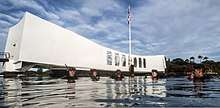
"NAVFAC Engineering & Expeditionary Warfare Center Ocean Facilities Department supports the Fleet through the support it gives the Underwater Construction Teams". UCTs deploy worldwide to conduct underwater construction, inspection, repair, and demolition operations of ocean facilities, to include repair of battle damage. They maintain a capability to support a Fleet Marine Force amphibious assault, subsequent combat service support ashore, and self-defense for their camp and facilities under construction. UCT1 is home ported at Virginia Beach, Virginia, while UCT2 is at Port Hueneme, California.
Public Works: U.S. Naval Bases: These units have CEC officers leading them and enlisted Seabees for the various crews. About one-third of new Seabees are assigned to Public Works Departments (PWD) at naval installations both within the United States and overseas. While stationed at a Public Works Department, a Seabee has the opportunity to get specialized training and extensive experience in one or more facets of their rating. Some bases have civilians that augment the Seabees, but the department is a military organization.
Combat Service Support Detachments (CSSD) / Naval Special Warfare (NSW)
Combat Service Support Detachments (CSSD) have several hundred Seabees assigned in support of Naval Special Warfare (NSW) units based out of Coronado, CA, and Virginia Beach, VA. Seabees provide the field support for power generation/distribution, logistical movement, vehicle repair, construction/maintenance of encampments, water purification or facilities.[207][208] Seabees assigned to support NSW receive extra training in first aid, small arms, driving, and specialized equipment.[207][208] and are expected to qualify as Expeditionary Warfare Specialists.[209] Seabees assigned to NSW are eligible to receive the following Naval Enlisted Classifications upon filling the requirements: 5306 – Naval Special Warfare (Combat Service Support) or 5307 – Naval Special Warfare (Combat Support).[210] They also can apply for selection to support the NSW Development Group.[211]
Training and Rates
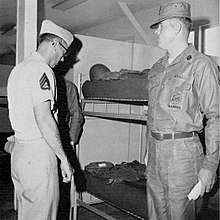
Trainees begin "A" School (trade school) upon completion of boot: 4 weeks classroom, 8 weeks hands-on. From "A" School, trainees most often report to a NMCB or ACB. There recruits go through four-weeks of Expeditionary Combat Skills (ECS) which is also required for those who report to a Navy Expeditionary Combat Command. ECS is basic training in: map reading, combat first aid, recon, and other combat-related skills. Half of each course is spent on basic marksmanship to qualify with a M16 rifle and the M9 service pistol. Those posted to Alfa Company of a NMCB may be assigned to a crew-served weapon: MK 19 40mm grenade launcher, the .50-caliber machine gun, or the M240 machine gun. Many reserve units still field the M60 machine gun. Seabees were last U.S. military to wear the U.S. Woodland camouflage uniform or the Desert Camouflage Uniform. They now have the Navy Working Uniform NWU Type III and use ALICE field gear. Some units, with the Marines, will use USMC-issue Improved Load Bearing Equipment (ILBE).
Current rates:[212][213] The current ratings were adopted by the Navy in 1948.
- BU : Builder
- CE : Construction Electrician
- CM : Construction Mechanic
- EA : Engineering aide
- EO : Equipment operator
- SW : Steelworker
- UT : Utilitiesman
The Seabee "constructionman" ranks of E-1 through E-3 are designated by sky-blue stripes on uniforms. The color was adopted in 1899 as a uniform trim color designating the Civil Engineer Corps, but was later given up. Its continued use is a bit of Naval Heritage in the NCF.
At paygrade E-8, the Builder, Steelworker, and Engineering Aide rates combine into a single rate: Senior Chief Constructionman (CUCS). At the E-9 paygrade they are referred to as a Master Chief Constructionman (CUCM).
The remaining Seabee rates combine only at the E-9 paygrade:
- Master Chief Equipmentman (EQCM) for Equipment Operator and Construction Mechanic.
- Master Chief Utilitiesman (UCCM) for Construction Electrician and Utilitiesman.



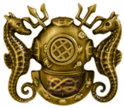
Diver : is a qualification that the various rates can obtain with three grades: Basic Underwater Construction Technician/ NEC 5932 (2nd Class Diver), Advanced Underwater Construction Technician/ NEC 5931 (1st Class Diver), and Master Underwater Construction Technician/ NEC 5933 (Master diver).[214] Seabee divers are attached to five principal commands outside the NCF:
- UCT ONE, Little Creek, VA.[215]
- UCT TWO, Port Hueneme, CA.[215]
- Naval Facilities Engineering Service Center (NFESC) that has detachments in Port Hueneme, CA, and in the Washington Navy Yard, DC. These are CEC officer billets only. Those at Port Hueneme are with the highly technical NFESC "Dive Locker Team".[216]
- Navy System Commands, e.g., NAVSEA or NAVAIR. These are CEC officer billets only.[215]
- NEDU/NDSTC (Navy Experimental Diving Unit – Navy Diving & Salvage Training Center)[215]
The "Seabee" and CB unit insignias
On 1 March 1942 the RADM Moreell recommended that an insignia be created to promote esprit de corps in the new CBs to ID their equipment as the Air corps did to ID squadrons. It was not intended for uniforms.[1]:136 Frank J. Iafrate, a civilian file clerk at Quonset Point Advance Naval Base, Davisville, Rhode Island, who created the original "Disney Style" Seabee. In early 1942 his design was sent to RADM Moreell who made a single request. That the Seabee being set inside a letter Q, for Quonset Point, be changed to a hawser rope and it would officially adopted.[217]
The Seabees had a second Logo. It was of a shirtless constructionman holding a sledge hammer with a rifle strapped across his back standing upon the words "Construimus Batuimus USN". The figure was on a shield with a blue field across the top and vertical red and white stripes. A small CEC logo is left of the figure and a small anchor is to the right. This logo was incorporated into many CB Unit insignias.[218]
During World War II, artists working for Disney Onsignia Department designed logos for about ten Seabee units including the: 60th NCB,[219] 78th NCB[219] 112th NCB,[220] and the 133rd NCB[221]. There are two Disney published Seabee logos that are not identified with any unit.[222]
The end of WWII brought the decommissioning of nearly all of the CBs. They had been in existence less than four years when this happened and the Navy had not created a Historical Branch or Archive for the NCF. So, there was no central archive for Seabee history. As time passed, first with Korea and then Vietnam, Construction Battalions were reactivated with the units having no idea what the WWII insignia had been so they made new ones.
Seabee Combat Warfare Insignia and Peltier Award

The military qualification badge for the Seabees is known as the Seabee combat warfare specialist insignia (SCW). It was created in 1993 for both officers and enlisted personnel. Only members attached to a qualifying NCF unit are eligible for the SCW pin. The qualifying units include: NMCBs, ACBs, NCF Support Units (NCFSU), UCTs, and NCRs.

The Fleet Marine Force Insignia or Fleet Marine Force pin (FMF pin), are for issue to those USN officers and enlisted trained and qualified to support the U. S. Marine Corps. Those Seabees assigned with the Fleet Marine Force can earn the FMF pin. The FMF pin comes in three classes : enlisted, officer, and chaplain. For requirements, see: Fleet Marine Force Warfare Specialist (EFMFWS) Program per OPNAV Instruction 1414.4B.
The Peltier Award is given to the "best of type" active duty Naval Construction Battalions. It was instituted by Rear Admiral Eugene J. Peltier CEC and has been given annually since 1960. He is a former head of the Bureau of Yards and Docks (1959–1962).
Seabee barge carriers
_amphibious_vehicle_assigned_to_Beachmaster_Unit_One_(BMU-1)_launches_from_the_Military_Sealift_Command_(MSC)_sea_barge_heavy_lift_ship_SS_Cape_Mohican_(T.jpg)
see: Seabee (barge)
There were six "Seabee" ships built:[223] the SS Cape Mendocino (T-AKR-5064), the SS Cape May (T-AKR-5063) and the SS Cape Mohican (T-AKR-5065). The other three of were operated by Lykes Brothers Steamship Company and were originally the SS Doctor Lykes, the SS Tillie Lykes, and the SS Almeria Lykes. The NCF primarily uses the Seabee barges . Barges with a 2.5' draft are loaded and floated to and from a mother container ship, facilitating loading and unloading of containerized cargo at sea. These ships have an elevator system for loading the barges out of the water at the stern onto the vessel. Loaded barges can then be moved toward the vessel's bow by means of a track to be stowed on one of three decks. Seabee barge carriers can store 38 barges, 12 each on the lower decks and 14 on the upper deck. The 38 barges can hold 160 containers. A barges measures 97'x35'.[224] A barge carrier also has storage tanks of nearly 36000 m³(9,510,194 gal.) volume built in its sides and double hull, allowing it to be used also as a tanker. The ships were purchased by Military Sealift Command.
Museums
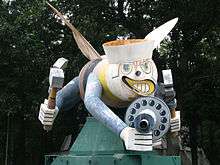
The U.S. Navy Seabee Museum[225] is located outside the main gate of Naval Base Ventura County, Port Hueneme, Ca. In July 2011 the new facility opened with galleries, grand hall, theater, storage, and research areas.
The Seabee Heritage Center is the Atlantic Coast Annex of the Seabee Museum in Port Hueneme.[226] It opened in 1995.[227] Exhibits at the Gulfport Annex are provided by the Seabee Museum in Port Hueneme.[228]
The Seabee Museum and Memorial Park[229] in Davisville, Rhode Island was opened in the late 1990s. A Fighting Seabee Statue is located there.
Notable Seabees
- Admiral Ben Moreell[230]
- CM3 Marvin Glenn Shields, Medal of Honor recipient posthumously and first sailor to receive one in the Vietnam War.
- CMCU Robert Stethem (Diver 2c), was posthumously awarded the Purple Heart and Bronze Star
- CM3 Brandon “Killer Bee” Wolff, former Navy SEAL and former Ultimate Fighting Championship Welterweight fighter.
- Cdr Blake Wayne Van Leer
See also
- Wikipedia:Articles with the most references
- Military engineering of the United States
- United States Navy Experimental Diving Unit
- Seabee Engineer Reconnaissance Team
- Seabees Memorial
- Unsinkable aircraft carrier
- USS Marvin Shields, now an Allende-class frigate
Other U.S. military construction/engineering organizations:
- RED HORSE – U.S. Air Force
- United States Army Corps of Engineers
- USMC Combat Engineers List of United States Marine Corps battalions
Notes
WWII


- WWII U.S.N. CB awards for valor were listed each month in All Hands along with the rest of the Navy.[231]
Marine Corps, Seabees outside the NCF
- When the 18th, 19th and 25th CBs were transferred to the Marine Corps they each were reduced by one company plus 1/5th of Hq Co to match the organization of a USMC battalion. B Co from the 25th CB[232] and C Co from the 18th CB[233] were used to form the 53rd CB. The other company was used to form the 121st CB.
- Due to Seabees being given advanced rank upon enlistment, enlisted Marines referred to construction battalions as "sergeant's battalions". USMC sergeants do not pull guard duty, so the ranked Seabees would not be assigned. The NCOs of the 18th wore USMC chevrons and not USN "crows" on their uniforms.[234]
- USN insignia on USMC issue.[235]
- Seabees were shore party for the Marines on Bougainville,[54] Peleliu,[236] Guam,[237] Purata Island,[238] Roi-Namur, Saipan,[239] Iwo Jima,[240] and Okinawa.[241] The Marines deployed them as combat engineers at Cape Gloucester,[242] Tarawa,[243] and Tinian.[244]
- The first Marines assigned to a CB were attached to CBD 1010 on Guam.[245] The 2nd Separate Marine Engineer Battalion was next, assigned to the 27th NCR with two former USMC CBs; the 25th and the 53rd.[246] In mid-August 1944 the 1st Separate Marine Engineer Battalion was assigned to the 30th NCR.[247] Prior, 100 Marines were assigned to the 71st CB on Bougainville.
NCDUs, Seabees outside the NCF
- NCDUs at Normandy: 11, 22–30, 41–46, 127–8, 130-42[76]
- The Joint Army Navy Experimental Testing (JANET) site for beach obstacle removal, Project DM-361, was located at the ex-Seabee base, Camp Bradford after the NCDU program moved.[248]
- 14 NCDUs were combined to create UDT 9, almost completely Seabees[88]
- NCDUs 200 – 216 were combined to create UDT 15.[79]


UDTs, Seabees outside the NCF
- The Naval Special Warfare Command building at the U.S.N. Seal base at Fort Pierce is named for Ltjg. Frank Kaine CEC commander of NCDU 2.
- General Donovan the head of the OSS approached General MacArthur and Admiral Nimitz about using OSS men in the Pacific[91] with Europe invaded. Gen. MacArthur had no interest.[91] Adm. Nimitz looked at Donovan's list and also said no, except he could use the swimmers from the Maritime Unit.[91] He was only interested in them for being swimmers not being OSS.
- Seabees outside the NCF, made naval history.[250] Admiral Turner recommended over 60 Silver Stars and over 300 Bronze Stars with Vs for the Seabees and other service members of UDTs 1-7[250] That was unpresendented in USN/USMC history.[250] For UDTs 5 and 7 at Tinian and UDTs 3 and 4 at Guam, all officers received a silver stars and all enlisted received bronze stars with Vs.[83] Adm. Conolly felt the commanders of teams 3 and 4 (Lt. Crist and Lt. W.G. Carberry) should have received Navy Crosses at Guam.[83]
- UDT 3 at formation had 11 CEC, 4 USN, 1 USMC Officers[88] Nearly all of the men from UDTs 1 and 2 were used to form UDTs 3 and 4.[79]
- UDT 7's officers went through "indoctrination" in "Area E" at Camp Peary.[88]
Seabee North Slope Oil Exploration 1944
- Seabee Creek was named by CBD 1058 and runs into the Colville River at Umiat, AK.
- USN geologists with CBD 1058 discovered the large Aupuk Gas Seep.[251]
Cold War: Korea – Seabee Teams
- In October 1965 MCB 11 had two Seabee Teams assigned to "Project Demo". The U.S. State Dept. tasked them with de-bugging U.S. embassies behind the iron curtain and repair the damage caused by the removal.[252][253]
Cold War: Antarctica
- Seabee Heights is a geologic feature of the Transantarctic mountains. It overlooks the Beardmore Glacier Seabee traverse route inland.
- Seabee Hook is located near the site of Hallett Station on the Ross sea.
Cold War: Vietnam
- Commander Naval Construction Battalion U.S. Pacific Fleet, Tân Sơn Nhất, Republic of Vietnam, Completion Report 1963–1972.
- Military training for CBs during this period lasted six weeks. Two weeks were at the respective homeport and four weeks with the Marines at Camp Lejuene or Camp Pendleton.

- Cold War projects: 1961 floating dry dock for Polaris submarines at Holy Loch, Scotland.[254] 1963 U.S. Naval Communications Listening Station Nea Makri, Greece.[254]
Cold War: CIA
- When CBD 1510 transferred to CBD 1504 it was designated for function similar to Acorns: Aviation and OTA.[255] The Navy's use of "OTA" denotes the assignment to the CIA in that Other Transaction Authority (OTA) is the term commonly used to refer to the (10 U.S.C. 2371b) authority of the Department of Defense (DoD) to carry out certain prototype, research and production projects."[256]
- In 2007 the Naval Expeditionary Combat Command (NECC) authorized funding forty Naval Intelligence billets in the NCF.[257] The goal was to have organic NCF Intelligence personnel. Historically the training officer would become the intelligence officer when a CB deployed.
- CIA redacted memorandum dated 14 June 1968 discusses the use on Naval Construction Personal/Seabees on a project.[258]
Iraq Afghanistan

- In 2015 ACB 1 moved the Orion (spacecraft) Boilerplate (spaceflight) test article for NASA at San Diego, CA.
Seabee insignia
- WWII Naval Construction Battalion Logos[261]
- CBs sponsored many B-29s on Tinian tagging the aircraft with Seabee unit insignia as nose art.[262][263][264]
Naval Support Unit
- In 1977 the U.S. Embassy in Moscow suffered a severe fire prompting the construction of a new one in 1979. At the construction site of the new embassy twenty to thirty Seabees were assigned to oversee 800 plus Russian construction workers.[265] This prompted the Russians to embed bugs in construction materials prior to delivery to the construction site. The success of the KGB in bugging the new embassy only reinforced the State Department's need for the Seabees.
SEABEE Barge Carriers
- Unusual Hull Design Requirements of the SEABEE Barge Carriers.[266]
References
- "Chapter VI: The Seabees". Building the Navy's Bases in World War II: History of the BuDocks and the CEC 1940–1946. Vol I. Washington, DC: U.S.GPO. 1947. Retrieved 18 October 2017 – via HyperWar.
- U.S. Marine Corps WWII Order of Battle, Gordon L. Rottman, Greenwood Press, Westport, CT, 2002, p. 32
- "Seabee History: Formation of the Seabees and World War II". NHHC. 2017. Retrieved 15 March 2017.
- Training the Fighting Seabees of WWII at Camp Peary, Daily Press, E-newspaper 3 Dec, 2017, Mark St. John Erickson, Newport News, VA.
- "Admiral Ben Moreell, CEC, USN". Seabee Museum and Memorial Park. Retrieved 18 October 2017.
- Coca-Cola and the Art of Seabee Acquisition, Seabee Museum, Seabee Museum website, Port Hueneme, CA.
- "SeaBees Name and Insignia Officially Authorized". Naval History Blog. U.S. Naval Institute. 29 February 2012. Retrieved 18 October 2017.
- "The Seabees". Flying (magazine). Vol. 35 no. 4. October 1944. p. 261. Retrieved 18 October 2017.
- Rogers, J. "U.S. Navy Seabees During World War II" (PDF). Retrieved 15 April 2020.
- Seabee History: Introduction, Naval History, and Heritage Command official U.S. Navy web site, Published: Fri Feb 17 06:36:45 EST 2017
- Docks, United States Bureau of Yards and (1947). Building the Navy's Bases in WWII: History of the BuDocks and the CEC, 1940-1946. U.S. GPO.
- Flags, Pennants & Customs, NTP 13 (B), Naval Computer And Telecommunications Command, Washington, DC, section 17.11, p. 17-5
- Introduction 2017.
- "Chapter IV: Bobcat". Dept. of the Navy Office of Naval Operations: The Logistics of Advance Bases: The Base Maintenance Division Op30 (Op415). Washington, DC: U. S. GPO. 1947. Retrieved 18 October 2017 – via HyperWar.
- "Seabee Unit Histories" (PDF). The NMCB 62 "Minutemen". Retrieved 18 October 2017.
- Rogers, J. David. "U.S. Navy Seabees During World War II" (PDF). Missouri University of Science and Technology. p. 8. Retrieved 18 October 2017.
- The King Bee, Capt. A. N. Olsen (CEC), Trafford Publishing, 2007 The King Bee
- "129th Seabees collection - State Archives - Kansas Historical Society". www.kshs.org. Retrieved 20 April 2020.
- Formation 2017.
- Schroder, Walter K.; Emma, Gloria A. (1999). Davisville and the Seabees. Arcadia Publishing.
- Navy Civil Engineer. NAVFAC Engineering Command. 1962.
- Battalion, 30th, United States Navy Construction (1945). The 30th Log, 1942-1944. U.S. Navy Seabee Museum.
- "Chapter VI: AB Units – Lions, Cubs, Acorns". Dept. of the Navy Office of Naval Operations: The Logistics of ABs: The Base Maintenance Div. Op30 (Op415). Washington, DC: U. S. GPO. 1947. Retrieved 18 October 2017 – via HyperWar.
- "Chapter XXVI: Bases in the Southwest Pacific". Building the Navy's Bases in WWII: History of the BuDocks and the CEC 1940–1946. I. Washington, DC: U.S. GPO. 1947. p. 120. Retrieved 18 October 2017.
- Rottman, Gordon L. (2002). World War II Pacific Island Guide: A Geo-military Study. Westport, CT: Greenwood Publishing Group. p. 78. Retrieved 18 October 2017.
- Building the Navy's Bases in WWII: History of the BuDocks and the CEC 1940–1946. II. Washington, DC: U.S. GPO. 1947. p. 264. Retrieved 18 October 2017.
- "Chapter V: Procurement and Logistics for ABs". Building the Navy's Bases in WWII: History of the BuDocks and the CEC 1940–1946. I. Washington, DC: U.S. GPO. 1947. Retrieved 18 October 2017 – via HyperWar.
- Camp Bedilion, Historic California Posts, NCBC, Port Hueneme, CA., State Military Museums, 2814 B Street, Sacramento, CA., 95816
- Building the Navy's Bases in WWII: History of the BuDocks and the CEC 1940–1946. I. Washington, DC: U.S. GPO. 1947. p. 130. Retrieved 18 October 2017.
- Seabees, U.S. Navy Official website, 12 August 2009
- "Chapter XXV: Campaign in the Solomons". Building the Navy's Bases in WWII: History of the BuDocks and the CEC 1940–1946. II. Washington, DC: U.S. GPO. 1947. Retrieved 18 October 2017 – via HyperWar.
- Seabees at the Rhine Crossing, Building the Navy's Bases in WWII, Volume II (Part III), Part III: The Advance Bases, U.S. Navy official website, published: Nov. 2018, p. 118
- "Chap. 5: Identification Badges/Awards/Insignia: #5319: Miscellaneous Devices". USN Uniform Regulations. NAVPERS. Retrieved 18 October 2017.
- Photo of a vet wearing CB insignia on USMC issue, U.S. Militaria Forum webpage
- Photo of: Marine with early Seabee insignia WWII, U.S. Militaria Forum
- Rottman, Gordon L. (2002). USMC WWII Order of Battle: Ground & Air units in the Pacific War, 1939–1945. Westport, CT: Greenwood Press. p. 31.
- The U.S. Navy’s Seabees: Bulldozing a Road to Victory, Glenn Barnett, Warfare History Network website, 2020, Sovereign Media, 6731 Whittier Ave, Suite C-100 McLean, VA.
- Rottman (2002), Fig. 4.2.
- Rottman (2002), Fig. 4.3.
- U.S . Marine Corps Pacific Theater of operations 1943–44, Gordon L. Rottman, Osprey Pub., Combat Mission Chapt., Engineer Regiments Section, 2004
- Rottman (2002) Fig. 4.2.1
- Bobcats-Bora bora, Chapter XXIV Bases in the South Pacific, Building the Navy's Bases in World War II, History of the BuDocks and the CEC, 1940–1946, Volume II. U.S GPO, Washington, DC, 1947, p. 202
- Ratomski, John J. "The 25th Naval Construction Battalion". World War II Stories in Their Own Words. Retrieved 18 October 2017.
- Rottman (2002), pp. 218–220.
- Rottman, Gordon L. (2004). Battle Orders: USMC Pacific Theater of Operations 1943–44. Osprey Publishing. p. 13.
- "WWII CB uniform, 1944 Leatherneck Magazine". weebly.com. Retrieved 18 October 2017.
- "43rd Seabees Wearing USMC Uniforms – Maui, Hawaii". seabee-rvn.com. Retrieved 18 October 2017.
- "Navy Seabees in Marine Corps Service Uniform". Uniforms of World War Two. Retrieved 18 October 2017.
- Ratomski, John J. "121st Naval Construction Battalion". World War II Stories in Their Own Words. Retrieved 18 October 2017.
- "Seabee Battalion List". seabees93.net. Retrieved 18 October 2007.
- Melson, Charles D. (2013). "The Munda Drive and the Fighting 9th". Up The Slot: Marines in the Central Solomons. Marines in World War II Commemorative Series. CreateSpace Independent Publishing Platform. Retrieved 18 October 2017.
- Ratomski, John J. "Peleliu Shore Party". Tribute to Michael A. Lazaro and all other Peleliu Veterans. Retrieved 18 October 2017.
- 71st U.S. NCB. Seabee Museum. p. 14.
- "Seabees!". WWII Forums. Retrieved 18 October 2017.
- Home World War II, Other WWII Unit Stories And Info: Bougainville Seabees by Thurman, 2006
- "WWII Seabees photos". Witness to War. Retrieved 18 October 2017.
- "4th Marine Division Operations Report, Iwo Jima, 19 February to 16 March, 1945". Ike Skelton Combined Arms Research Library Digital Library. Retrieved 18 October 2017. Open PDFs 6 and 7 for Appendix 1 Annex Dog (Shore Party Log D-Day–D+18)
- Annex Uncle, 5th Marine Div. Operations Report, April 1945, National Archives, College Park, Md.
- The 5th Marine Division in WWII, Lt. John C. Chapin, Historical Div., Hq, USMC, Aug 1945, Appendix B, Component Units
- 8th NCB cruise book, 1946, Seabee Museum Archive, Port Hueneme, CA. p. 83/142
- Building the Navy's Bases in WWII: History of the BuDocks and the CEC 1940–1946. II. Washington, DC: U.S. GPO. 1947. p. 470. Retrieved 18 October 2017.
- 53rd Naval Construction Battalion: the Marine Seabee 1st M.A.C. U.S. Navy Seabee Museum. pp. 14 & 106.
- 25th Naval Construction Battalion Cruisebook, p. 97 [file:///C:/Users/cbuser01/Downloads/25%20NCB%201942-45.pdf]
- "USN Seabee Museum Archives". Picssr. Retrieved 18 October 2017.
- Chapter XXVIII, Bases in the Marianas and Iwo Jima, Building the Navy's Bases in WWII, History of the BuDocks and the CEC, 1940–1946, Vol I, U.S. GPO, Washington, DC, 1947, p. 347
- Kester, Charles (January 1963). "Can Do!". Leatherneck. p. 30. Retrieved 18 October 2017.
- Third Marine Div. Assoc. (1992). Third Marine Division's Two Score and Ten History. Turner Pub. Comp. p. 162. Retrieved 18 October 2017.
- The King Bee Pens Foreword for Book On World War II Seabees, The Navy Civil Engineer, Sept. 1963, Vol. 4, No 9, Admiral Moreell, p. 4 [https://books.google.com/books?id=GWlrJTKd5lAC&pg=RA11-PA28&lpg=RA11-PA28&dq=The+navy+civil+engineer,+September+1963&source=bl&ots=6LEgoQv1s4&sig=ACfU3U0FjY_iaMNRZkigYrTjXybZrGfpGg&hl=en&sa=X&ved=2ahUKEwj2pajYqfjoAhXMGc0KHS8IDWsQ6AEwAHoECAkQAQ#v=onepage&q=The%20navy%20civil%20engineer%2C%20September%201963&f=false}
- Blazich, Frank A. (6 June 2014). "Opening Omaha Beach: Ensign Karnowski and NCDU-45". Seabees Online. Washington Navy Yard, DC: Navy Facilities Engineering Command. Retrieved 18 October 2017.
- Blazich, Frank A. (12 May 2017). "This Week in Seabee History (Week of May 14)". Seabees Online. Navy Facilities Engineering Command. Retrieved 18 October 2017.
- "Naval Combat Demolitions Units". SpecWarNet.net. Retrieved 18 October 2017.
- NCDU Officer class photo (note CEC insignia above cuff) 1988.0022.23, Navy Seal Archives, Fort Pierce, FL
- This Week in Seabee History: 3–9 June, Official Online Magazine of the U.S. Navy Seabees, Naval Facilities Engineering Command.
- "Naval Combat Demolitions Units". SpecWarNet.net. Retrieved 18 October 2017.
- Report on Naval Combat Demolition Units in Operation "NEPTUNE" as part of Task Force 122, Lt.(jg) H. L. Blackwell, Jr., USNR, 5 July 1944.
- Navy Divers, Bureau of Naval Personnel Information Bulletin, All Hands, September 1944, p. 23, Evansville Vanderburgh Public Library, Indiana
- Naval History and Heritage Command website, Part 2 – Unit Awards, 31 Aug 2015
- The Water Is Never Cold, James Douglas O'Dell, 2000, p. 132, Brassey's, Dulles, VA.
- World War II US Navy Special Warfare Units, Eugene Lipak, Osprey Publishing, New York, 2014, p. 25
- Navy SEAL History Part One, A Glance at the Origins of Naval Special Warfare, 1 August 2018 By MC2 Taylor Stinson, Defense Media Activity, All Hands Magazine, Defense Media Activity, U.S. DOD
- SEAL History: Origins of Naval Special Warfare–WWII, National Navy UDT–SEAL Museum, Fort Pierce, FL.
- Naked Warriors, Cdt. Francis Douglas Fane USNR (Ret.), St. Martin's Press, New York, 1996, pp. 122, 131
- Lt Crist, "The MOCK-UP", Fort Pierce ATB Newspaper, 20 July 1945 , p. 4, Fort Pierce SEAL Archives, Fort Pierce, FL
- UDTs 1 & 2, The Marshall Islands, Kwajalein, Roi-Namur, Eniwetok, U. S. Naval Special Warfare Archives
- The Underwater Demolition Teams of the Pacific, Pearl Harbor Visitors Bureau,
- "The Teams in World War II". View of the Rockies. Retrieved 18 October 2017.
- "The Teams in World War II". View of the Rockies. Retrieved 18 October 2017.
- Interview with Wright S. Travis (11/20/2007)Comment #30 "Seabees as UDTs", he was member of OSS Maritime Unit attached to UDT 10, The Library of Congress, American Folklife Center, Veterans History Project, Library of Congress, Washington, DC
- Blazich, Frank A. (12 September 2016). "This Week in Seabee History (Week of September 11)". Seabees Online. NavFac Engineering Command. Retrieved 18 October 2017.
- OSS in Action The Pacific and the Far East, Series: OSS Training in the Nat. Parks and Service Abroad in World War II, Catoctin Mountain Park, Prince William Forest Park, August, 2017, Nat. Park Service, Washington, DC
- "WWII UDT One & WWII UDT Two". View of the Rockies. Retrieved 18 October 2017.
- Hoyt, Edwin P. (2011). SEALs at War. Random House Publishing. p. 25. Retrieved 18 October 2017.
- Kelly, Orr (24 June 2014). Brave Men, Dark Waters: The Untold Story of the Navy SEALs. Open Road Media. p. 30. Retrieved 18 October 2017.
- The Water is Never Cold), James Douglas O'Dell, Brassey's, Dulles, VA, 2001, p. 136
- Naked Warriors, Cdmr. Francis Douglas Fane USNR (Ret.), St. Martin's Press, New York, 1996, p. 828
- Naval Construction Maintenance Unit 570 Historical Information, Seabee Museum Archives, Port Hueneme, CA.
- Underwater Demolition Team Histories, WWII UDT Team Eight, U.S. Naval Special Warfare Archives,
- Underwater Demolition, "All Hands", The Bureau of Naval Personal Information Bulletin, October 1945, NAVPERS-0 Number 343 pp. 12–15
- NCDU 216 Photo, National Navy UDT–SEAL Museum, North Hutchinson Island, Fort Pierce, FL
- Antill, Peter (2003), Peleliu, battle for (Operation Stalemate II) – The Pacific War's Forgotten Battle, September–November 1944, "Hitting the Beach 3rd paragraph"
- Magazine, Seabee. "Building for a Nation and Equality: African American Seabees in World War II".
- This week in Seabee History, Sept 17–23, Seabee Online Magazine, NAVFAC Engineering Command, Wash. Navy Yard, DC. live.mil/326-2/
- Historical Content Significance, Naval Aviation Supply Depot Hut 33 at Waiawa Gulch, Peral City, U.S. Dept of Interior, Nat. Park Service, p. 10
- "17th Special NCB cruisebook" (PDF). NHHC. pp. 29, 30. Retrieved 18 October 2017.
- "Seabees of 17th Special Naval Construction Battalion wait to assist wounded of 7th Marines". World War II Database. Retrieved 18 October 2017.
- "African-American Marines of 16th Field Depot Rest on Peleliu". World War II Database. Retrieved 18 October 2017.
- "17th Special NCB" (PDF). NHHC. Retrieved 18 October 2017.
- Princeton University Library, Marine Corps Chevron, Vol 3 No. 48, 2 Dec. 1944
- Peleliu, battle for (Operation Stalemate II) – The Pacific War's Forgotten Battle, Sept–Nov 1944, (section: Hitting the Beach, 3rd paragraph), Military History Encyclopedia on the Web, by: Peter D. Antill, Tristan Dugdale-Pointon, and Dr. John Rickard,
- 1st Marine Pioneers, Presidential Unit Citation, 1st Marine Div., Reinforced, Assault and seizure of Peleliu and Ngesebus, Palau Islands, Part II. Unit Awards, Section 1, Navy-Marine Corps Awards Manual (Rev 1953) p. 15 Naval History and Heritage Command,
- The Right to Fight:African American Marines in WWII, Peleliu and Iwo Jima, Bernard C. Naulty, Marine Corps Historical Center, Washington Navy Yard, Washington, DC, 1974,
- African Americans at War: an Encyclopedia, Vol. I, Jonathan D. Sutherland, ABC, CLIO, Santa Barabra, CA, 2004, p. 480,
- "17th Special NCB cruisebook" (PDF). NHHC. p. 29. Retrieved 18 October 2017.
- The Sextant, Building for a Nation and for Equality: African American Seabees in World War II – March 4, 2014, Dr. Frank A. Blazich Jr., U.S. Navy Seabee Museum, NHHC
- Breaking Down Barriers: The 34th NCB, Seabee Museum online, Port Huemene, CA. Feb 2018
- Exploration of Naval Petroleum Reserve No. 4 and Adjacent Areas Northern Alaska, 1944–53 Part 1, History of the Exploration By John C. Reed, CDR, USNR, Geological Survey Professional Paper 301 Prepared and published at the request of and in cooperation with the U. S. Dept. of the Navy, Office of Naval Petroleum and Oil Shale Reserves, US GPO, Washington: 1958, pp. 4, 23
- ComIcePac, CBD 1058, 1945, Seabee Museum, Port Hueneme, CA
- Kiska Sector, Chapter XXII, Bases in Alaska and the Aleutians, Building the Navy's Bases in World War II, History of the BuDocks and the CEC, 1940–1946, Volume II, U.S.Gov. Printing Office, Washington, DC, 1947, p. 188-90
- Dept. of the Interior U.S. Geological Survey Selected Data from Fourteen Wildcat Wells in the NPR in Alaska, USGS Open File Report 00-200, Wildcat Well Seabee 1, Dept. of the Interior, U.S. Geological Survey, Central Region Energy Resources Team, Denver, CO
- Division of Geological & Geophysical Surveys Preliminary Interpretive Report 2008-1, Preliminary Results Of Recent Geologic Field Investigations in the Brooks Range Foothills and North Slope, Alaska by Marwan A. Wartes and Paul L. Decker, March 2008, Released by State of Alaska, Dept. of Natural Resources, Div. of Geological & Geophysical Surveys, Fairbanks, AK.
- Exploration of the Petroleum Reserve No. 4 and Adjacent Areas, Northern Alaska 1944–53, Part 1, History of the Exploration, John C. Reed, Cdr, CEC, Geological Survey Professional Paper 301, U.S. Gov. Printing Office, Washington, DC, 1958, pp. 21–46
- Alaska Legacy Wells Summary Report:NPR Alaska, Rob Brumbaugh, Stan Porhola, BLM/AK/ST-05/004+2360+941, November 2004, U.S. Dept. of Interior Bureau of Land Management
- Southeast Asia: Building the Bases, Richard Tregaskis, 1975, p. 16, U.S. Gov. Printing Office, Washington, DC
- The 114th CB cruisebook, 1946, U.S. Navy Seabee Museum Archives, Port Hueneme, Ca, pp. 123–125
- This Week in Seabee History 30 Sept – 6 Oct, Seabee museum Archives, Port Hueneme, CA.
- Yanks in Siberia: U.S. Navy Weather Stations in Soviet East Asia, 1945, G. Patrick March, Pacific Historical Review, Vol. 57, No. 3 (Aug. 1988), pp. 327–342, Published by: University of California Press.
- Building the Navy's Bases in World War II, History of the BuDocks and the CEC, 1940–1946, Volume I, US GPO Washington, 1947, Seabees in China, p. 416
- 33rd Special Naval Construction Battalion file, 1946, Seabee Museum Archives, Port Hueneme, CA.
- Building the Navy's Bases in World War II: History of the BuDocks and the CEC 1940–1946. II. Washington, DC: U.S. GPO. 1947. p. 416. Retrieved 18 October 2017.
- Naval History and Heritage Command, Naval History and Heritage Command, Washington Navy Yard, DC
- Operations Crossroads, DNA 6032F, prepared by the Defense Nuclear Agency, pp. 190–91
- Rottman, Gordon L. (2002). U.S. Marine Corps World War II Order of Battle: Ground and Air units in the Pacific War, 1939–1945. Westport, CN: Greenwood Press. p. 224.
- Blazich, Frank A. (30 July 2017). "This Week in Seabee History (Week of July 30 – August 5)". Seabees Online. Navy Facilities Engineering Command. Retrieved 18 October 2017.
- Operations Crossroads, DNA 6032F, prepared by the Defense Nuclear Agency, p. 189
- Naval Construction Battalion Detachment 1504 file, Seabee Museum Archives, Port Hueneme, CA.
- Operation Crippled Chick, ACB 1 Builds Emergency Airstrip Behind Enemy Lines, By Steve Karoly, The Seabeecook
- SERT, Seabee Engineer Reconnaissance Team, Andrew G. Wright of the Engineering News-Record, Seabee Magazine Special Commemorative Double Issue 2003, Naval Facilities Engineering Command (NAVFAC), Attn: SEABEE Online (Code PA), , Washington Navy Yard, DC, p. 69.
- The Forgotten Fifty Five, NCB93: 113RD Seabees detachment assigned to PT Squadrons, Seabees93.net
- Construction Battalion Detachments 1802, 1803, NHHC, Seabee Museum, Port Hueneme Ca
- "Seabee History: South east Asia", Naval History and Heritage Command Online reading room, published 16 Apr, 2015
- Seabee Teams in Vietnam 1963–69, Thomas A. Johnson, Createspace Independent Publishing Platform, 2010, ISBN 9781461192107
- Commander Naval Construction Battalion U.S. Pacific Fleet, Tân Sơn Nhất, Republic of Vietnam, Completion Report 1963–1972.
- Commander Naval Construction Battalion U.S. Pacific Fleet, Tân Sơn Nhất, Republic of Vietnam, Completion Report 1963–1972. p. 4-7 /4-12
- "Civic Action Team: Building Friendships".
- "Building and Enduring Presence", The Military Engineer, LTJG Frances Hunter & Lt. James A. Harder (NMCB 11), Nov–Dec 2017, Society of American Military Engineers, Alexandria, VA
- "Operation Highjump" Air & Space Magazine, July 2007, Smithsonian Institution, Washington, DC
- Magazine, Seabee. "This Week in Seabee History (Week of Jan. 17)".
- Sabbatini, Mark. "Heavy duty champ turns 50". The Antarctic Sun. Retrieved 18 October 2017.
- Reid, Tyler (21 March 2014). "Nuclear Power at McMurdo Station". Stanford University. Retrieved 18 October 2017.
- Blazich, Frank A. (27 August 2014). "Rendezvous with Penguins: Seabee Construction of the South Pole Dome". Seabees Online. NAVFAC Engineering Command. Retrieved 18 October 2017.
- "This Week in Seabee History (Week of February 14)".
- The Largest Military Construction Project in History, Vietnam '67, The New York Times, Mel Schenck, Vietnam, January 16, 2018
- Tucker, Spencer C., ed. (2011). "Seabees". The Encyclopedia of the Vietnam War: A Political, Social, and Military History (2nd ed.). Santa Barbara, CA: ABC-CLIO. p. 1023. ISBN 978-1-85109-961-0. Retrieved 18 October 2017.
- U.S. Navy Seabees – The Vietnam Years, Terry Lukanic, ', 2017
- Temporary Facilities, 4.5.1.1 Role in the Cold War, Regional Cold War History for DOD Installations in Guam and Northern Mariana Islands, Jayne Aaron, July 2011, Department of Defense Legacy Program , p. 4–26 (94/198)
- MCB 1 Cruisebook 1966, p. 57–58, Seabee Museum, Port Hueneme, CA
- U.S. Navy Seabees to drop anchor in Walla Walla Oct. 6-9, Walla Walla Union-Bulletin, 2016-09-28
- NAVCAT 12 patch, Lee-Jackson Militaria, San Jose, CA
- Southeast Asia, Building the Bases, Richard Tregaskis, U.S. GPO, 1975, p. 403
- Agent Orange clean at Navy Seabee base is the focus at public meeting, reported by Natalie Campen, WLOX TV, Gulfport, MS | July 9, 2013 at 3:04 PM CDT
- The History, Use, Disposition and Environmental Fate of Agent Orange, Chapt 7: Monitoring Studies of Former Agent Orange Storage Sites in Mississippi and Johnston Island, Alvin L. Young, Springer Publishing, 2008,
- Public Health Assessment, Naval Construction Battalion Center Gulfport, Mississippi, Facility ID No. MS2170022626, April 2005, prepared by: Federal Facilities Assessment Branch, Division of Health Assessment and Consultation, Agency for Toxic Substances and Disease Registry
- United States Navy and Marine Corps Bases: Domestic, Paolo E. Coletta, Greenwood Press, Westport, CT, 1986. p. 495
- MCB10 cruisebook 1963, Seabee Museum Archives, Port Hueneme,CA
- All Hands, June 1969, Number 629, Navy Dept. Washington, DC. p. 39
- Seabeemagazine online Seabeemagazine online
- "Project Tektite: The Aquanauts That Lived in the Sea". 11 August 2016.
- St. John Historical Society, St. John, US Virgin Islands, Crystal Blue View of Tektite II
- U.S. Navy Seabee Museum online magazine, "Project Tektite and the Birth of the Underwater Construction Teams" by Dr. Frank A. Blazich Jr., Historian, U.S. Navy Seabee Museum
- ACB 1 Helps NASA Lift Off, MC3 Eric Chan, Public Affairs Office ACB 1, Seabee Magazine Online, 2016, Seabee Museum Archives, Port Hueneme,CA
- ACB-1 Teams-Up with NASA, MC2 Brianna Jones ACB 1 Public Affairs Office, Seabee Online, Seabee Museum Archives, Port Hueneme,CA.
- PHIBCB TWO SUPPORTS NASA, MC3 Taylor Mohr, Public Affairs Office ACB 2, Seabee Online, Seabee Museum Archives, Port Hueneme,CA.
- The Incredible Psyop of USMC Lt. Robert Bruce Sheeks on Saipan, Perspectives, Journal of the Psychological Operations Association, Fall 2018, Cold War Covert Activities on Saipan, SGM Herbert A. Friedman (Ret.), William H. Stewart, Posted Dec 21 2004
- Naval Technical Training Unit (NTTU), Northern Mariana Islands, Tanapag website.
- Cold War covert activities on Saipan, elsewhere in the region| Posted on Dec 21 2004, Saipan Tribune,
- NTTU Saipan, December 25, 2017, "The Pentagon Papers", Gravel Edition, Volume 2; (2) Prados, John, "President's Secret Wars", William Morrow Company, New York, 1986; John Wilson, Sr., NTTU-1959–'62
- Cruise Book, MCB 9, Detachment Able, Saipan 1954
- Naval Mobile Construction Battalion 10 , NHHC, Seabee Museum Archives, Port Hueneme CA.
- Radio Swan: Seabees Part of Cold War History, Seabee Magazine online, Kenneth Van Belkum, Commander, CEC (retired), OIC of Det. Tango, Seabee Museum, Port Hueneme, CA
- "The Critical Mission of Providing Diplomatic Security: Through the Eyes of a U.S. Navy Seabee". DipNote.
- "This Week in Seabee History (Week of April 16)".
- History of the Bureau of Diplomatic Security of the United States Department of State, Chapter 5 – Spies, Leaks, Bugs, and Diplomats, written by State Department Historian's Office, pp. 179–80, U.S. State Department
- Chapter 1, US Navy Basic Military Requirements for Seabees
- Department of State, Justice, Commerce, the Judiciary and related Agencies appropriations for 1966, Hearings...Dept of State, p. 6 M
- August 26, This Week in Seabee History (August 26 – September 1), by Dr. Frank A. Blazich Jr, NHHC, Naval Facilities Engineering Command (NAVFAC), Washington Navy Yard, DC
- "Washington to Send a U.S. Support Staff to Missions in Soviet Union", Bernard Gwertzman, The New York Times, October 25, 1986
- "Protecting Information". U.S. Department of State. Retrieved 18 October 2017.
- US Navy Basic Military Requirements for Seabees, Chapter 1, p. 11
- Barker, J. Craig (2016). The Protection of Diplomatic Personnel. New York: Routledge. p. 92. ISBN 978-1-317-01879-7.
- "From bugs to bombs, little-known Seabee unit protects US embassies from threats", Stars and Stripes, April 26, 2018,
- Seabee History: After Vietnam, Published: Apr 16, 2015, NHHC, Official U.S. Navy web site
- Woman in the CEC and the Seabees, Seabee Museum, Port Hueneme, Ca.
- David, About Camp (11 August 2013). "Working at Camp David".
- CNIC, Naval Support Facility Thurmont website, P.O. Box 1000, Thurmont, MD 21788-5001
- Seabee History: After Vietnam, Published: Thu Apr 16 13:53:14 EDT 2015, NHHC, Official U.S. Navy web site
- Seabee History: The US Navy in Operation Enduring Freedom, 2001–2002: Aug. 18, 2017, NHHC, Official U.S. Navy web site
- Mroczkowski, Dennis P. (2005). "Chapter 8: Normality Begins to Return" (PDF). Restoring Hope in Somalia with the Unified Task Force 1992–1993. Quantico, Virginia: History and Museums Division, Marine Corps University. Retrieved 18 October 2017.
- "Hurricane Relief", Seabee magazine, Winter 2006
- McAvoy, Audrey (20 November 2012). "Seabees Complete Disaster Recovery Mission". Military.com. Retrieved 19 December 2015.
- "US Navy Provides Disaster Relief in the Aftermath of Hurricane Sandy". Defense Media Activity. 11 April 2017. Retrieved 25 April 2017.
- Smith, Daryl C. (6 April 2013). "First Naval Construction Division Decommissioned". Naval Station Norfolk Public Affairs. Retrieved 19 December 2015.
- "History". National Seabee Divers Association.
- CBMU 202, Official website of the Naval Construction Force, CLF_GLFP_WebMaster@navy.mil
- CBMU 303,Official website of the Naval Construction Force, CLF_GLFP_WebMaster@navy.mil
- Whittenberger, Katt. "Seabee Recognized for Supporting Naval Special Warfare". Naval Special Warfare Group 2 Public Affairs. Retrieved 31 August 2016.
- "Building Camp NSW" (PDF). Ethos. No. 16. pp. 24–27. Retrieved 18 October 2017.
- "We salute you Naval Special Warfare technician" (PDF). Ethos. No. 3. pp. 5–6. Retrieved 18 October 2017.
- "Navy Enlisted Classifications (Chapter 4 )" (PDF). U.S. Navy BuPers. Archived from the original (PDF) on 12 October 2016. Retrieved 18 October 2017.
- "Recruitment/Assignment To Commander, Naval Special Warfare Development Group (COMNAVSPECWARDEVGRU)" (PDF). U.S. Navy BuPers. Retrieved 18 October 2017.
- "Manual of Navy Enlisted Manpower and Personnel Classifications and Occupational Standards". Navy Personnel Command. Retrieved 18 October 2017.
- Underwood, Annalisa. "The U.S. Navy Seabees: Rates to Remember". The Sextant. Retrieved 18 October 2017.
- Navy Seabee UCT Diver Challenge, Navy CyberSpace
- U.S. Navy Diving, Lesson N2b.v2, United States Naval Academy, Spring 2012, Seabee Diver/CEC
- Issue No. 1, 2005, Seabee Magazine, p. 19, Naval Facilities Engineering Command, Washington Navy Yard DC
- "Origin of the SeaBee logo". Albertville 94th Battalion, U.S. Naval Sea Cadet Corps. Retrieved 18 October 2017.
- "U.S. Navy Seabee Museum". Picssr. Retrieved 18 October 2017.
- Daly, John (31 July 2013). "Disney Insignia from World War II". USNI News. Retrieved 18 October 2017.
- "112th Naval Construction Battalion Logo". Flickr.com. 25 March 2011. Retrieved 18 October 2017.
- 133 Naval Construction Battalion Log, 1946, p.6, Seabee Museum Archives, Port Hueneme, CA133 NCB Cruisebook NHHC: Seabee Museum
- Disney Don's Dogtags, Walton Rawls, Abbeville Press, 1992
- "Where have the barge carriers gone?" American shipper, Howard Publications Inc., Capt. James Mcnamara, April 18, 2015
- Doctor Lykes, Marad, U.S. Dept of Transportation, Maritime Administration, Washington, DC
- "Seabee Museum". Naval History and Heritage Command. Retrieved 18 October 2017.
- "Welcome". U.S. Navy Seabee Museum. 10 January 2012. Archived from the original on 15 May 2015.
- "A Guide to the U.S. Navy Museum Facilities in the United States". Naval History and Heritage Command. 10 January 2012. Archived from the original on 23 October 2012.
- "The Museum & Heritage Center". CEC/Seabee Historical Foundation. Retrieved 10 January 2012.
- "Home". Seabee Museum and Memorial Park. Retrieved 18 October 2017.
- "Adm. Ben Moreell, CEC, USN: Founder of the Seabees and shaper of the modern Civil Engineer Corps". U.S. Navy Seabee Museum. Naval History and Heritage Command. 24 March 2017. Retrieved 18 October 2017.
- Valor Awards, All Hands, Defense Media Activity for U.S. Navy Office of Information
- 25th Naval Construction Unit History, Seabee Museum Archives, Port Hueneme, CA p.o
- 18th Naval Construction Battalion Log, date 2-8-43, Navy Seabee Museum website, Port Hueneme, CA'
- Huie, Willam Bradford (1945). From Omaha to Okinawa: The Story of the Seabees. New York: E.P. Dutton.
- Insignia table, Group II: Hospital Corpsmen and Seabees assigned to Marine Units, U.S. Navy Marks (and others)on Marine Uniforms, John A. Stacey, 2005, Published by John A. Stacey, 2880 Smith Point Road, Nanjemoy, Maryland 20662, Dept. of the Navy, Naval Historical Center, Wash. Navy Yard, DC, p. 4
- Ratomski, John J. "Peleliu Shore Party". Tribute to Michael A. Lazaro and all other Peleliu Veterans. Retrieved 18 October 2017.
- 25th Naval Construction Battalion: Pacific Diary. U.S. Navy Seabee Museum. p. 116. Retrieved 18 October 2017.
- "Seabees!". WWII Forums. Retrieved 18 October 2017.
- Crowl, Philip A. (1959). "Chapter VII: Supporting Arms and Operations". U.S. Army in World War II, The War in the Pacific, Campaign in the Marianas. U.S. Army. p. 125. Retrieved 18 October 2017.
- "4th Marine Division Operations Report, Iwo Jima, 19 February to 16 March, 1945". Ike Skelton Combined Arms Research Library Digital Library. Retrieved 18 October 2017. Open PDFs 6 and 7 for Appendix 1 Annex Dog (Shore Party Log D-Day–D+18)
- Nichols, Charles S. (1955). "Appendix IV". Okinawa: Victory in the Pacific. Quantico, VA: USMC Historical Section, United States Marine Corps. Retrieved 18 October 2017.
- Blazich, Frank A. (23 December 2015). "This Week in Seabee History (Week of December 20)". Seabees Online. Navy Facilities Engineering Command. Retrieved 18 October 2017.
- "TarawaTalk – Tarawa Seabees". DiscussionApp. 20 November 2009. Retrieved 18 October 2017.
- Rottman, Gordon L. (2002). U.S. Marine Corps World War II Order of Battle: Ground and Air units in the Pacific War, 1939–1945. Westport, CN: Greenwood Press. p. 328. ISBN 9780313319068. Retrieved 18 October 2017.
- Seabee News Service, The BuDocks, 11 July 1944, p. 4
- 5th Naval Construction Brigade, NHHC, p. 9, Navy Seabee Museum, Port Hueneme, CA.
- 6th Naval Construction Brigade Log, published by Commodore P.J. Halloran, printed by 92nd CB, 1945, p. 12/38, Seabee Museum Archives, Port Hueneme, CA.
- Joint-Service Beach Obstacle Demolition in World War II, James Douglas O'Dell, April–June 2005, p. 36–40
- D-Day, the Normandy Invasion: Combat Demolition Units, Naval History and Heritage Command official U.S. Navy web site
- America's First Frogman, Elizabeth K. Bush, Naval Institute Press, Annapolis, MD, 2012, Chapt. 7
- Geochemistry of the Aupuk Gas Seep Along the Colville River—Evidence for a Thermogenic Origin, by Paul L. Decker and Marwan A. Wartes, Alaska Division of Oil & Gas, Anchorage, AK, p. 1
- MCB 11 cruisebook 1964–65, pp. 66/102 Seabee Museum Archive, Port Hueneme, CA.
- Spy "Bugs" Open New Worlds for Seabees to Conquer, CIA library reading room
- U.S. Navy BMR study guide
- Entry dated: 1.21.48, p. 2, CBD 1504 records, NHHC, Seabee Museum Archives, Port Hueneme, CA.
- Other Transaction Authority (OTA), AcqNotes/ Defense Acquisition University, Fort Belvoir, VA
- Seabees Deploy First Intelligence Superhighway, NNS070614-02 Release Date: 6/14/2007, CMC Shane Montgomery, 30th NCR Public Affairs
- Availability of Naval Construction Battalion (SEABEE) Personnel for Renovation and Construction Duties (Sanitized), CIA Library, Document Number (FOIA) : CIA-RDP78-04986A000100010008-6, published June 19, 1968, released March 19, 2001
- Issue No. 1, 2005 SEABEE Magazine, p. 21, NavFac Engineering Command, Washington Navy Yard, DC
- Marines, official website of the Marine Corps
- Naval Construction Battalion Logos, U.S. Navy Seabee Museum, Port Hueneme, CA
- Bowden, Mark. "Naval Construction Battalions (Seabees)". USAAF Nose Art Research Project. Retrieved 18 October 2017.
- "Nose Art Tinian". b-29.org. Retrieved 18 October 2017.
- "B-29 Superfortress WW2 heavy bomber designed by Boeing". World War Photos. Retrieved 18 October 2017.
- "Cleaning the Bug House", by Peter Grier, Air Force Magazine, September 2012
- Unusual Hull Design Requirements, Construction Operating Experience of the SEABEE Barge Carriers by Stuart W. Thayer, Member, Lykes Bros. Steamship Co., Inc., New Orleans, LA, and Alfred H. Schwendtner, Associate Member, J. J. Henry Co., Inc., New York, The Society of Naval Architects and Marine Engineers, New York, Presented at the Ship Structure Symposium, Washington, DC, October 6–8, 1975
General sources
- "Seabee History: Between the Second World War and the Korean War". Naval History and Heritage Command. 1 July 2015. Retrieved 15 March 2017.
Further reading
- A Brief History of USOM Support to the Office of Accelerated Rural Development, prepared by USOM Office of Field Operations, James W. Dawson, Assistant Program Officer, Sept, 1969
- COM-ICE-PAC, reports CBD 1058, Lt. Harry F. Corbin, ChC, CBD 1058, 1956
- Exploration of the Petroleum Reserve No. 4 and Adjacent Areas, Northern Alaska 1944–53, Part 1, History of the Exploration, Cmdr. John C. Reed CEC, Geological Survey Professional Paper 301, U.S. GPO, Washington, DC, 1958, pp. 21–46
- History of the SEABEES, Command Historian, Naval Facilities Engineering Command, 1996,
- Gropman, Alan (1997). The Big 'L' : American logistics in World War II. Diane Publishing. p. 244. ISBN 9781428981355.
- Kubic, Charles R.; Rife, James P. (2009). Bridges to Baghdad: The US Navy Seabees in the Iraq War. Thomas Publications.
- Nichols, Gina (2007). The Seabees at Gulfport. Charleston, SC: Arcadia Publishing.
- Hettema, Arthur D. "My Experience With U.D.T. at Luzon and Iwo Jima".
- MILPERSMAN 1306–919, Naval Support Unit State Dept.
- NAVPERS 15,790 (REV 1953), Navy and Marine Corps Awards Manual, Dept of the Navy, Unit Awards, Part II,
- NAVEDTRA-14234A, USN BMR for Seabee Combat Handbook 14234A. USN BMR online
- Peleliu 1944, Jim Moran Gordon L Rottman, Osprey Publishing, 2012, "Black Shore party"
- Tektite and the Birth of the Underwater Construction Teams by Dr. Frank A. Blazich Jr., Historian, U.S. Navy Seabee Museum
- Test Wells, Umiat Area Alaska, Florence I. Rucker Collins, Exploration Of Naval Petroleum Reserve No. 4 and Adjacent Areas, Northern Alaska, 1944–53, Part 5, Subsurface Geology And Engineering Data, Geological Survey Professional Paper 305-B, U. S. Dept. of the Navy, Office of Naval Petroleum and Oil Shale Reserves, U.S. GPO, Washington, DC: 1958
- Capt. A. N. Olsen (CEC), The King Bee, Trafford Publishing, 2007
- Thesis: USAWC Strategy Research Project, The effectiveness of the Seabee in Employing New Concepts During Operation Iraqi Freedom, Cmdr. Marshall Sykes USN, U.S. Army War College, Carlisle Barracks, PA, 2005.
- Thesis: U.S. Navy Seabees as a Stability Asset, Aaron W. Park, 2009, Naval Postgraduate School, Monterey, CA
- Thesis: "Navy Seabees: Versatile Instruments of Power Projection", Master of Military Studies: Lt Cmdr. Wernher C. Heyres, CEC, USN, 2013, USMC Command & Staff College, Marine Corps University, Quantico, VA
- Tregaskis, Richard (1972). Southeast Asia: Building the Bases. Washington, DC: U.S. GPO.
- United States Navy Construction Battalions, Seabees in Action, Seabee Teams, published by: Dept. of the Navy, Naval Facilities Engineering Command, 1967, Washington, DC
- "All gave some, some gave all: 17th Special CB, Bob Sohrt/Full Memoirs, Featured WWII Memoirs/Stories" (click: branch of service: Marines) Witness to War website, p. 4 of 11
External links
| Wikimedia Commons has media related to United States Navy Seabees. |
- Camille and the Seabees (1971)
- Official website
- Report_EuropeanOperations Seabees Report: European Operations (1945)
- Seabees. Department of the Navy. Bureau of Yards and Docks (c. 1944)
- Seabee Divers
- Seabee History, Naval History & Heritage Command
- Seabee & CEC Historical Foundation
- Seabees in the Antarctic: Base Construction
- Seabee Online: official online magazine of the Seabees
- Seabee Unit Histories and Cruisebooks at the Seabee Museum
- The Marston Mat and Seabee
- The Pacific War Online Encyclopedia
- U.S. Navy Seabee Museum Online Reading Room
- U.S. Navy Divers Training Center
